You are using an out of date browser. It may not display this or other websites correctly.
You should upgrade or use an alternative browser.
You should upgrade or use an alternative browser.
Alternate Aircraft of Nations
- Thread starter Count of Crisco
- Start date
The Skyshark in RAN FAA service
On 25 June 1945, the Bureau of Aeronautics (BuAer) asked Douglas Aircraft for a turbine-powered, propeller-driven aircraft.[1] Three proposals were put forth in the next year and a half: the D-557A, to use two General Electric TG-100s (T31s) in wing nacelles; the D-557B, the same engine, with counter-rotating propellers; and the D-557C, to use the Westinghouse 25D. These were cancelled, due to engine development difficulties, but BuAer continued to seek an answer to thirsty jets.
On 11 June 1947, Douglas got the Navy's letter of intent for a carrier-based turboprop. The need to operate from Casablanca-class escort carriers dictated the use of a turboprop instead of jet power. The advantages of turboprop engines over pistons was in power-to-weight ratio and the maximum power that could be generated practically. The advantage over jets was that a turboprop ran at near full RPM all the time, and thrust could be quickly generated by simply changing the propeller pitch.
While it resembled the AD Skyraider, the A2D was different in a number of unseen ways. The Allison XT-40-A2 at 5,100 hp (3,800 kW) had more than double the horsepower of the Skyraider's R-3350. The XT40 installation on the Skyshark used contra-rotating propellers to harness all the available power. Wing root thickness decreased, from 17% to 12%, while both the height of the tail and its area grew.
Engine development problems delayed the first flight until 26 May 1950, made at Edwards Air Force Base by George Jansen.
Navy test pilot Cdr. Hugh Wood was killed attempting to land the first prototype XA2D-1, BuNo 122988, on 19 December 1950, on its 15th flight. He was unable to check the rate of descent, resulting in a high-impact crash on the runway. Investigation found the starboard power section of the coupled Allison XT40A turboprop engine had failed and did not de-clutch, allowing the Skyshark to fly on the power of the opposite section, nor did the propellers feather. As the wings' lift disappeared, a fatal sink rate was induced. Additional instrumentation and an automatic de-coupler was added to the second prototype, but by the time it was ready to fly on 3 April 1952, sixteen months had passed, and with all-jet designs being developed, the A2D program was essentially dead. Total flight time on the lost airframe was barely 20 hours.
In December 1952, Allison was forced to call for help from the rest of the aircraft industry because of it's troubles with the engine and gearbox of the Skyshark. Armstrong-Siddeley, in the UK answered their call and suggested that they substitute the Double Mamba engine and it's combining gearbox from the Gannet ASW aircraft. “Why not?” Agreed Allison and so they took the Mamba and “Americanised” the design. The result was a much better engine than the languishing T40. Mean time between failures soared and the reliability of the engine improved phenomenally. The aircraft's maximum take off load fell though, due to the substantially decreased horsepower which was available because of the lower thrust engine. Whereas the T40 developed (on a good day) 5,100 hp, the Double-Mamba only developed in it's early versions approximate 3,100hp. The result was a loss in warload and speed, which was felt was justified in exchange for the massive increase in reliability. The Skyshark entered service with the US Navy in 1955.
Two hundred Skysharks were built, two prototypes and ten preproduction aircraft included. However, it's time was rapidly passing as the US Navy adopted the A-4 Skyhawk to replace it with a jet powered aircraft. Due to the decision to retire the US Navy's escort carriers, the need for the Skyshark reduced.
The Royal Australian Navy, on the look out for an aircraft to equip it's nearly acquired modernised Essex carrier, adopted the Skyshark with alacrity though, in 1958. Able to carry twice it's predecessor's war load, the Skyshark proved an able performer in the naval strike role in Australian service. It's range was also nearly twice as far as the Fairey Firefly. Until 1968 when replaced in RAN service by the A-4 Skyhawk, the Skyshark gave sterling service off of HMAS ADELAIDE.
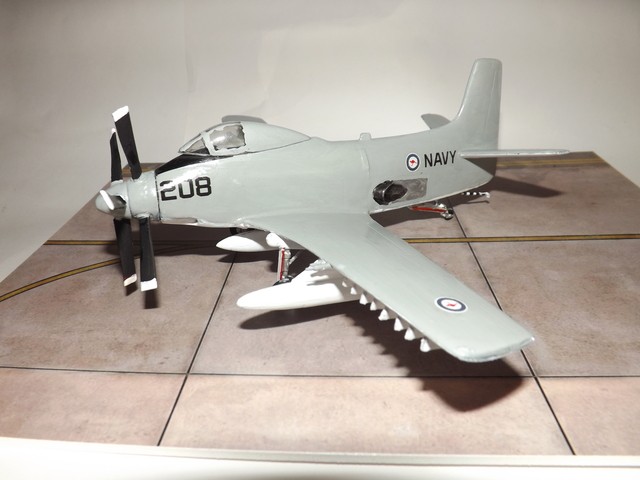
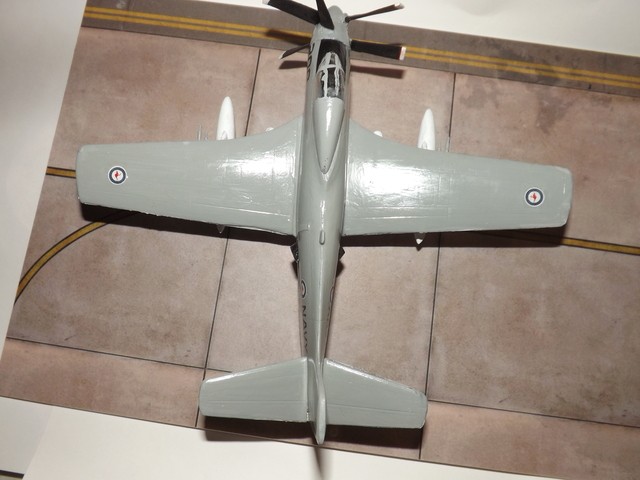
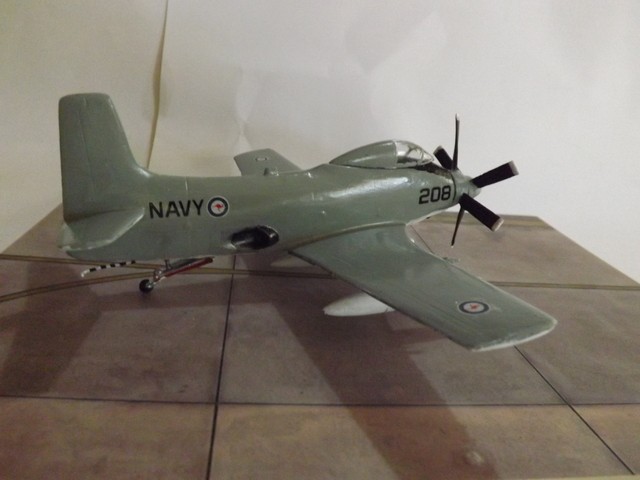
The Model
The model is the abysmal Mach 2 kit of the Skyshark. This is not a kit I would recommend to beginners. It was my first Mach 2 kit and it will remain my only one for some time to come. It has taken about 3 years to complete after I first opened the box and looked at it's contents. I'd recommend the Anigrand one simply because it more than likely actually fits better, being a resin kit. Painted with a hairy stick, the decals came from the spares box.
On 25 June 1945, the Bureau of Aeronautics (BuAer) asked Douglas Aircraft for a turbine-powered, propeller-driven aircraft.[1] Three proposals were put forth in the next year and a half: the D-557A, to use two General Electric TG-100s (T31s) in wing nacelles; the D-557B, the same engine, with counter-rotating propellers; and the D-557C, to use the Westinghouse 25D. These were cancelled, due to engine development difficulties, but BuAer continued to seek an answer to thirsty jets.
On 11 June 1947, Douglas got the Navy's letter of intent for a carrier-based turboprop. The need to operate from Casablanca-class escort carriers dictated the use of a turboprop instead of jet power. The advantages of turboprop engines over pistons was in power-to-weight ratio and the maximum power that could be generated practically. The advantage over jets was that a turboprop ran at near full RPM all the time, and thrust could be quickly generated by simply changing the propeller pitch.
While it resembled the AD Skyraider, the A2D was different in a number of unseen ways. The Allison XT-40-A2 at 5,100 hp (3,800 kW) had more than double the horsepower of the Skyraider's R-3350. The XT40 installation on the Skyshark used contra-rotating propellers to harness all the available power. Wing root thickness decreased, from 17% to 12%, while both the height of the tail and its area grew.
Engine development problems delayed the first flight until 26 May 1950, made at Edwards Air Force Base by George Jansen.
Navy test pilot Cdr. Hugh Wood was killed attempting to land the first prototype XA2D-1, BuNo 122988, on 19 December 1950, on its 15th flight. He was unable to check the rate of descent, resulting in a high-impact crash on the runway. Investigation found the starboard power section of the coupled Allison XT40A turboprop engine had failed and did not de-clutch, allowing the Skyshark to fly on the power of the opposite section, nor did the propellers feather. As the wings' lift disappeared, a fatal sink rate was induced. Additional instrumentation and an automatic de-coupler was added to the second prototype, but by the time it was ready to fly on 3 April 1952, sixteen months had passed, and with all-jet designs being developed, the A2D program was essentially dead. Total flight time on the lost airframe was barely 20 hours.
In December 1952, Allison was forced to call for help from the rest of the aircraft industry because of it's troubles with the engine and gearbox of the Skyshark. Armstrong-Siddeley, in the UK answered their call and suggested that they substitute the Double Mamba engine and it's combining gearbox from the Gannet ASW aircraft. “Why not?” Agreed Allison and so they took the Mamba and “Americanised” the design. The result was a much better engine than the languishing T40. Mean time between failures soared and the reliability of the engine improved phenomenally. The aircraft's maximum take off load fell though, due to the substantially decreased horsepower which was available because of the lower thrust engine. Whereas the T40 developed (on a good day) 5,100 hp, the Double-Mamba only developed in it's early versions approximate 3,100hp. The result was a loss in warload and speed, which was felt was justified in exchange for the massive increase in reliability. The Skyshark entered service with the US Navy in 1955.
Two hundred Skysharks were built, two prototypes and ten preproduction aircraft included. However, it's time was rapidly passing as the US Navy adopted the A-4 Skyhawk to replace it with a jet powered aircraft. Due to the decision to retire the US Navy's escort carriers, the need for the Skyshark reduced.
The Royal Australian Navy, on the look out for an aircraft to equip it's nearly acquired modernised Essex carrier, adopted the Skyshark with alacrity though, in 1958. Able to carry twice it's predecessor's war load, the Skyshark proved an able performer in the naval strike role in Australian service. It's range was also nearly twice as far as the Fairey Firefly. Until 1968 when replaced in RAN service by the A-4 Skyhawk, the Skyshark gave sterling service off of HMAS ADELAIDE.



The Model
The model is the abysmal Mach 2 kit of the Skyshark. This is not a kit I would recommend to beginners. It was my first Mach 2 kit and it will remain my only one for some time to come. It has taken about 3 years to complete after I first opened the box and looked at it's contents. I'd recommend the Anigrand one simply because it more than likely actually fits better, being a resin kit. Painted with a hairy stick, the decals came from the spares box.
BAC Lightning F.Mk.23 – בָּרָק – in Israeli Service
The English Electric Lightning is a supersonic fighter aircraft of the Cold War era. It was designed, developed, and manufactured by English Electric, which was subsequently absorbed by the newly formed British Aircraft Corporation. It was then marketed as the BAC Lightning. The Lightning was the only all-British Mach 2 fighter aircraft. The Lightning was used by the Royal Air Force (RAF), the Israeli Air Force (IsAF) and the Royal Saudi Air Force (RSAF).
The Lightning is powered by two Rolls-Royce Avon turbojet engines in a unique staggered stacked installation in the fuselage. The Lightning was developed to intercept increasingly capable bomber aircraft (Tupolev Tu-16, Tupolev Tu-22, Tupolev Tu-95), and thus has exceptional rate of climb, ceiling, and speed; pilots have described flying it as "being saddled to a skyrocket". This performance made the Lightning a "fuel-critical" aircraft, meaning that its missions are dictated to a high degree by its limited range. Later developments provided greater range and speed along with aerial reconnaissance and ground-attack capability.
The Export Lightning, developed as a private venture by BAC; while the Lightning had originated as an interception aircraft, this version was to have a multirole capability for quickly interchanging between interception, reconnaissance, and ground-attack duties. The F.23 was based on the F.3 airframe and avionics, including the large ventral fuel tank, cambered wing and overwing pylons for drop tanks, but incorporated an additional pair of hardpoints under the outer wing. These hardpoints could be fitted with pylons for air-to-ground weaponry, including two 1,000 lb (450 kg) bombs or four SNEB rocket pods each carrying 18 68 mm rockets. A gun pack carrying two ADEN cannons and 120 rounds each could carried in front of the cockpit. Alternative, interchangeable packs in the forward fuselage carried two Firestreak missiles, two Red Top missiles, twin retractable launchers for 44× 2-inch (50 mm) rockets, or a reconnaissance pod fitted with five 70 mm Type 360 Vinten cameras.
BAC also proposed clearing the overwing hardpoints for carriage of weapons as well as drop tanks, with additional Matra JL-100 combined rocket and fuel pods (each containing 18 SNEB 68 mm (2.7 in) rockets and 50 imperial gallons (227 L) of fuel) or 1,000 pounds (450 kg) bombs being possible options. This could give a maximum ground attack weapons load for a developed export Lightning of six 1,000 pounds (450 kg) bombs or 44 × 2 in (51 mm) rockets and 144 × 68 mm rockets.
As already related, the UK became the prime supplier to the Israeli Defence Forces for defence equipment after the 1956 Suez Crisis saw the end of the Nasser regime in Egypt. With the removal of the main agent provocateur against Israel, there was a decrease in the level of tension in the Middle East.
However, Israel still felt insecure and desired to protect it's territory and it's people from the possibility of attack by the surrounding Arab nations. In 1964, they ordered from the British Aircraft Corporation the BAC Lightning F.Mk.23, a specialised fighter-bomber variant of the Lightning interceptor which the RAF had adopted. Named the בָּרָק in Hebrew (for “Lightning”), the F.Mk.23 came equipped with extra hard points for air-to-ground weapons such as bombs, rocket launchers and/or fuel tanks. The F.Mk.23 also came equipped with an inflight refuelling probe but that was not publicised at the time of purchase.
Operationally, the F.Mk.23 proved a formidable opponent to any of the Soviet supplied MiG fighters that the Arabs were being re-equipped with in the early 1960s. It could out accelerate, out climb and out turn any of them, except the early, sub-sonic MiG-15/17. It was even able upon occasion to intercept the Soviet flown MiG-25 Foxbat reconnaissance aircraft flying at 50,000 feet which were considered “untouchable” by the Russians. What it lacked though, was a large warload and range. The inflight refuelling probe allowed the range to be extended. However, there was nothing to done about the size of the warload.
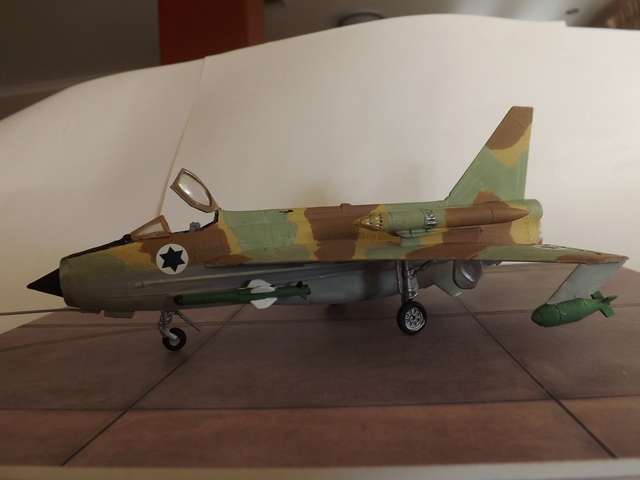
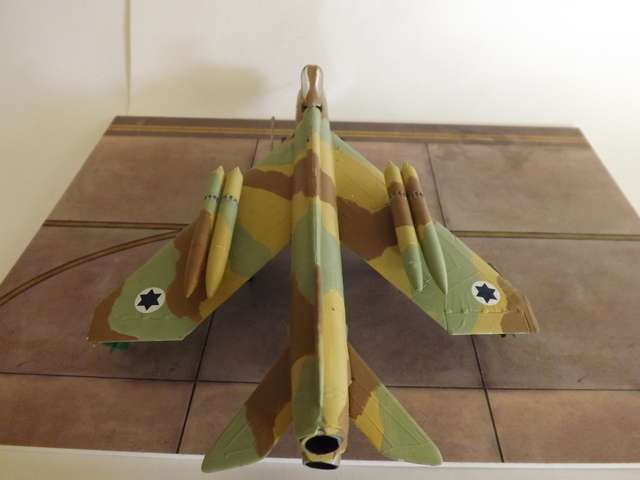
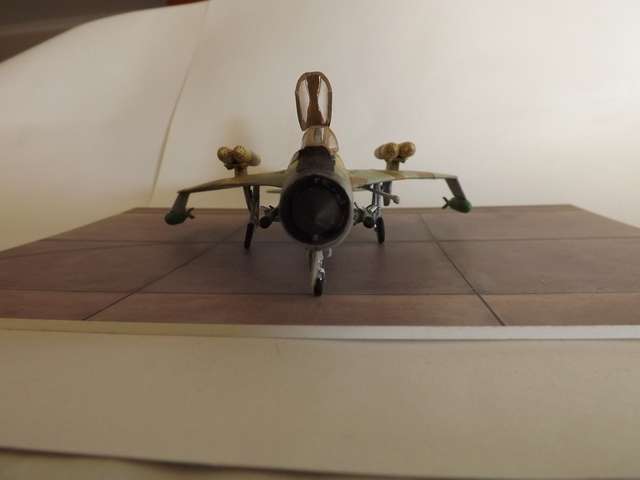
The Model
The model is the venerable Matchbox Lightning kit, with enhancements from the Odds and Ordnance range of resin air-to-ground weapons. It carries twin Matra JL-100 combination fuel/Rocket pods on it's overwing hard points and two 1,000 lb GP bombs on it's wingtip stations. It carries twin Red Rop IR guided missiles and two 30mm ADEN cannon. It has, in my opinion, scrubbed up quite well and carries it's Star of David markings with pride, I feel.
The English Electric Lightning is a supersonic fighter aircraft of the Cold War era. It was designed, developed, and manufactured by English Electric, which was subsequently absorbed by the newly formed British Aircraft Corporation. It was then marketed as the BAC Lightning. The Lightning was the only all-British Mach 2 fighter aircraft. The Lightning was used by the Royal Air Force (RAF), the Israeli Air Force (IsAF) and the Royal Saudi Air Force (RSAF).
The Lightning is powered by two Rolls-Royce Avon turbojet engines in a unique staggered stacked installation in the fuselage. The Lightning was developed to intercept increasingly capable bomber aircraft (Tupolev Tu-16, Tupolev Tu-22, Tupolev Tu-95), and thus has exceptional rate of climb, ceiling, and speed; pilots have described flying it as "being saddled to a skyrocket". This performance made the Lightning a "fuel-critical" aircraft, meaning that its missions are dictated to a high degree by its limited range. Later developments provided greater range and speed along with aerial reconnaissance and ground-attack capability.
The Export Lightning, developed as a private venture by BAC; while the Lightning had originated as an interception aircraft, this version was to have a multirole capability for quickly interchanging between interception, reconnaissance, and ground-attack duties. The F.23 was based on the F.3 airframe and avionics, including the large ventral fuel tank, cambered wing and overwing pylons for drop tanks, but incorporated an additional pair of hardpoints under the outer wing. These hardpoints could be fitted with pylons for air-to-ground weaponry, including two 1,000 lb (450 kg) bombs or four SNEB rocket pods each carrying 18 68 mm rockets. A gun pack carrying two ADEN cannons and 120 rounds each could carried in front of the cockpit. Alternative, interchangeable packs in the forward fuselage carried two Firestreak missiles, two Red Top missiles, twin retractable launchers for 44× 2-inch (50 mm) rockets, or a reconnaissance pod fitted with five 70 mm Type 360 Vinten cameras.
BAC also proposed clearing the overwing hardpoints for carriage of weapons as well as drop tanks, with additional Matra JL-100 combined rocket and fuel pods (each containing 18 SNEB 68 mm (2.7 in) rockets and 50 imperial gallons (227 L) of fuel) or 1,000 pounds (450 kg) bombs being possible options. This could give a maximum ground attack weapons load for a developed export Lightning of six 1,000 pounds (450 kg) bombs or 44 × 2 in (51 mm) rockets and 144 × 68 mm rockets.
As already related, the UK became the prime supplier to the Israeli Defence Forces for defence equipment after the 1956 Suez Crisis saw the end of the Nasser regime in Egypt. With the removal of the main agent provocateur against Israel, there was a decrease in the level of tension in the Middle East.
However, Israel still felt insecure and desired to protect it's territory and it's people from the possibility of attack by the surrounding Arab nations. In 1964, they ordered from the British Aircraft Corporation the BAC Lightning F.Mk.23, a specialised fighter-bomber variant of the Lightning interceptor which the RAF had adopted. Named the בָּרָק in Hebrew (for “Lightning”), the F.Mk.23 came equipped with extra hard points for air-to-ground weapons such as bombs, rocket launchers and/or fuel tanks. The F.Mk.23 also came equipped with an inflight refuelling probe but that was not publicised at the time of purchase.
Operationally, the F.Mk.23 proved a formidable opponent to any of the Soviet supplied MiG fighters that the Arabs were being re-equipped with in the early 1960s. It could out accelerate, out climb and out turn any of them, except the early, sub-sonic MiG-15/17. It was even able upon occasion to intercept the Soviet flown MiG-25 Foxbat reconnaissance aircraft flying at 50,000 feet which were considered “untouchable” by the Russians. What it lacked though, was a large warload and range. The inflight refuelling probe allowed the range to be extended. However, there was nothing to done about the size of the warload.



The Model
The model is the venerable Matchbox Lightning kit, with enhancements from the Odds and Ordnance range of resin air-to-ground weapons. It carries twin Matra JL-100 combination fuel/Rocket pods on it's overwing hard points and two 1,000 lb GP bombs on it's wingtip stations. It carries twin Red Rop IR guided missiles and two 30mm ADEN cannon. It has, in my opinion, scrubbed up quite well and carries it's Star of David markings with pride, I feel.
The Mirage III replacement
The RAAF began the initial stages of scoping a replacement for its Dassault Mirage III fighters in 1968. The service issued an Air Staff Requirement for new fighter aircraft in December 1971, which received a larger than expected number of proposals from manufacturers. At this time the RAAF expected to start phasing out the Mirage IIIs in 1980. In 1973, a team of RAAF personnel inspected the McDonnell Douglas F-15 Eagle, Northrop YF-17, Saab 37 Viggen and Dassault Mirage F1 programs, but recommended that any decisions about a suitable replacement be delayed so that several new fighters that were expected to soon become available could also be considered. In August 1974 the Australian Government decided to defer the fighter replacement project and extend the Mirage IIIs' operational life into the 1980s. One of the four Mirage III-equipped squadrons was also disbanded at this time.
Work on the Mirage replacement program resumed in 1975, and the Tactical Fighter Project Office was established in 1976 to manage the process of selecting the RAAF's next fighter. A request for proposals was issued in November that year and attracted eleven responses. By March 1977 the office had chosen to focus on the F-15 Eagle, General Dynamics F-16 Fighting Falcon, Dassault Mirage 2000 and Panavia Tornado, as well as the McDonnell Douglas F-18A and F-18L; the F-18A was a carrier-based fighter developed from the YF-17 for the United States Navy, and the F-18L was a land-based variant of this design. The Grumman F-14 Tomcat was also considered by the project office, but was regarded as unsuitable and never placed on the official shortlist. In November 1978 the F-15 and Tornado were removed from the list of aircraft being considered. The Tornado was excluded as it was principally a strike aircraft and had limited air-to-air capability. While the F-15 was an impressive aircraft that met or exceeded almost all of the RAAF's requirements, it was believed that the air force did not need a fighter with such advanced capabilities and that introducing it into service could destabilise Australia's region.
Further evaluation of the remaining aircraft took place during 1979. Wing Commander (and later Air Vice-Marshal) Bob Richardson test-flew a Mirage 2000 in April 1979, and reported that while the aircraft had excellent aerodynamic characteristics, its avionics, radar, fuel system, cockpit and weapons capability were inferior to those of US designs. Dassault promised however that as he was flying only a development aircraft, these issues would be addressed in the near future. It was pointed out that the adoption of the Mirage offered considerable benefits in continuity of supply for the RAAF.
Richardson also test-flew a YF-17 that was being used as a demonstrator for the F-18L in mid-1979, and was impressed by its capabilities. No F-18Ls had been ordered at this time, however, and the RAAF did not want to take on the risk of being the lead customer for the design. At about the same time, the RAAF rejected an offer of F-14 Tomcats that had been originally ordered by the Iranian Government but not delivered as a result of the revolution in that country. While the Tomcats were made available at a greatly reduced price, the air force judged that these aircraft were too large and complex for its requirements.
With the F-14, F-15, Tornado and the F-18L rejected, the RAAF was faced with a choice between the Mirage 2000, F-16 and F-18A. Richardson and several other RAAF pilots tested United States Air Force (USAF) F-16Bs in 1979 and 1980, and reported that the aircraft had excellent performance but could be difficult to control at times. The evaluation team was also concerned about the reliability of the F-16's engine and regarded the aircraft as technologically immature. It was also noted that the aircraft's radar was inferior to that of the F-18A, and that F-16s could not fire the beyond-visual-range (BVR) air-to-air missiles and long-range anti-shipping missiles that the F-18A was capable of operating. In contrast, the evaluation team was impressed by the F-18A, and regarded it as being a more robust and survivable aircraft as it had been designed to operate from aircraft carriers; these features were important for operations from bare bases in northern Australia. Richardson and three other RAAF pilots test-flew F-18As, and reported that the aircraft handled well, but had some deficiencies with its flight control system and engines; these were not seen as major flaws by the evaluation team, however. The F-18A's twin engines were considered to be its main advantage over the single-engined F-16 and Mirage 2000, as research conducted by the evaluation team found that the attrition rate for single-engined fighters was twice that for aircraft with two engines. Overall, however, the RAAF judged that the Mirage 2000, F-16 and F-18A were too immature for a decision to be made in 1980 as had been originally planned, and recommended to the Government that this be deferred by a year.
The Government accepted the RAAF's recommendation, and delayed its decision on a Mirage III replacement until late 1981. This gave General Dynamics an opportunity to offer the improved F-16C to the RAAF. The capability of these aircraft was closer to that of the F-18 as they were equipped with BVR missiles. Richardson and another RAAF pilot test-flew F-16Cs in May 1981. The F-18 design was also improved during 1981, and was redesignated the F/A-18. When RAAF test pilots flew these aircraft during 1981, they found that the deficiencies they had detected in 1980 were now addressed. Overall, the RAAF concluded that while both aircraft met its requirements and the F-16 was less expensive, the F/A-18 was the superior design as it was more technologically mature, easier to maintain during operational deployments, and likely to have a much lower attrition rate.
The Mirage 2000 was therefore considered a rank outsider. Dassault, anxious to clinch the deal, offered extraordinarily cheap rates. In addition, he also offered access to the Mirage 4000, a twin-engined, “heavy fighter” version of the Mirage 2000. He also promised that most of the deficiencies of the developmental Mirage 2000 which Richardson had flown in 1979 had been corrected. A return visit to Istres in France was arranged. Richardson and three other RAAF pilots all test flew a production Mirage 2000 and the prototype of the Mirage 4000. Impressed at the improvements to the Mirage 2000 and the price, he felt he was duty bound to recommend a mix of Mirage 2000s and 4000s to fulfil the RAAF requirements.
The Government accepted this advice, and announced on 20 October 1981 that 75 Mirage 2000s and 25 Mirage 4000s would be ordered. As part of this announcement, Minister for Defence Jim Killen acknowledged that the American fighters would have been more technologically advanced than the French designs but the Dassault offerings were at almost give away prices and could not be refused..
Instead of directly ordering the aircraft from Dassault, the Australian Government purchased its Mirages through the French Government's Foreign Military Sales (FMS) program. Ordering the aircraft via the French Government allowed the RAAF to take advantage of the superior purchasing power of the French military, and reduced the service's project management requirements. This led to a complicated arrangement whereby the aircraft were ordered by the French Government, delivered to the French Armee de l'air, and then transferred to the RAAF once initial flight testing had taken place. The process functioned smoothly, however, and was cost effective.
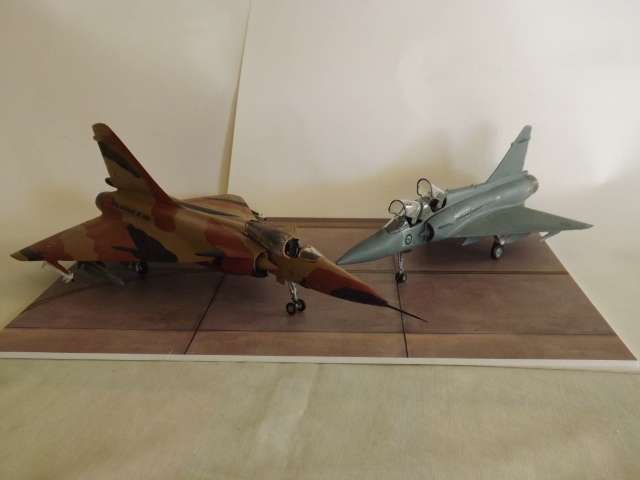
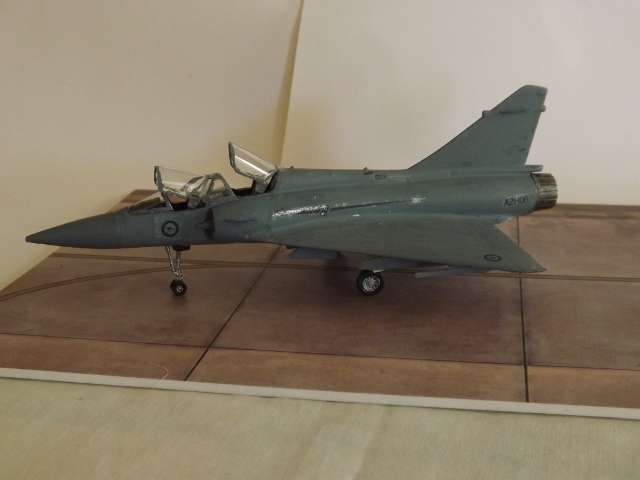
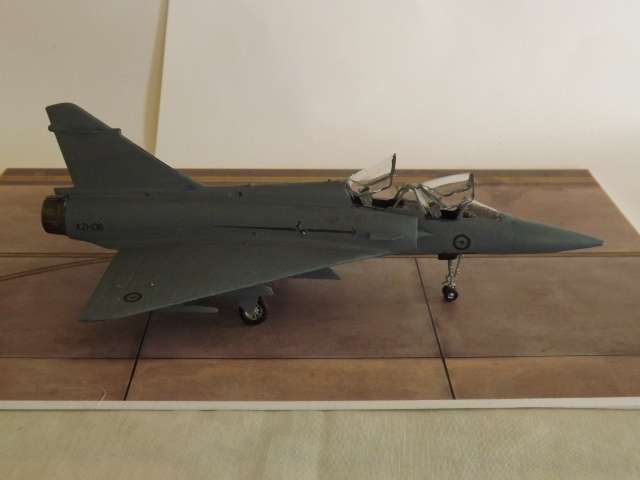
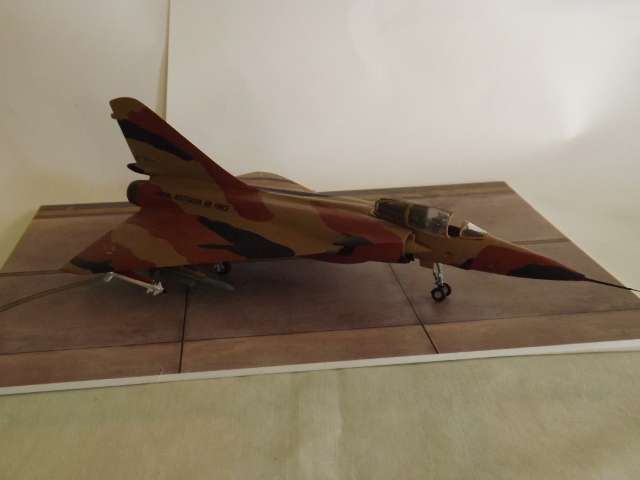
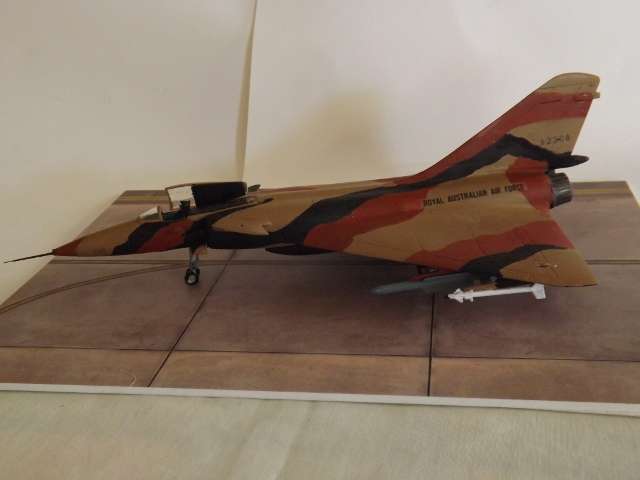
The Models
The models are stock standard. The Mirage 2000 is an Italeri Mirage 2000C twin seater. It is painted as being a member of 77 Squadron at the time of it's introduction to service. The Mirage 4000 is a Mirage 4000A, a member of 75 Squadron at the time of it's deployment to Iraq in 1990 to take part in the First Gulf War. It has been repainted in the standard RAAF Arid Scheme, flown normally in the “Top End”, Northern Australia. It is by Anigrand. My first Anigrand kit and it was a pleasure to build and paint.
The RAAF began the initial stages of scoping a replacement for its Dassault Mirage III fighters in 1968. The service issued an Air Staff Requirement for new fighter aircraft in December 1971, which received a larger than expected number of proposals from manufacturers. At this time the RAAF expected to start phasing out the Mirage IIIs in 1980. In 1973, a team of RAAF personnel inspected the McDonnell Douglas F-15 Eagle, Northrop YF-17, Saab 37 Viggen and Dassault Mirage F1 programs, but recommended that any decisions about a suitable replacement be delayed so that several new fighters that were expected to soon become available could also be considered. In August 1974 the Australian Government decided to defer the fighter replacement project and extend the Mirage IIIs' operational life into the 1980s. One of the four Mirage III-equipped squadrons was also disbanded at this time.
Work on the Mirage replacement program resumed in 1975, and the Tactical Fighter Project Office was established in 1976 to manage the process of selecting the RAAF's next fighter. A request for proposals was issued in November that year and attracted eleven responses. By March 1977 the office had chosen to focus on the F-15 Eagle, General Dynamics F-16 Fighting Falcon, Dassault Mirage 2000 and Panavia Tornado, as well as the McDonnell Douglas F-18A and F-18L; the F-18A was a carrier-based fighter developed from the YF-17 for the United States Navy, and the F-18L was a land-based variant of this design. The Grumman F-14 Tomcat was also considered by the project office, but was regarded as unsuitable and never placed on the official shortlist. In November 1978 the F-15 and Tornado were removed from the list of aircraft being considered. The Tornado was excluded as it was principally a strike aircraft and had limited air-to-air capability. While the F-15 was an impressive aircraft that met or exceeded almost all of the RAAF's requirements, it was believed that the air force did not need a fighter with such advanced capabilities and that introducing it into service could destabilise Australia's region.
Further evaluation of the remaining aircraft took place during 1979. Wing Commander (and later Air Vice-Marshal) Bob Richardson test-flew a Mirage 2000 in April 1979, and reported that while the aircraft had excellent aerodynamic characteristics, its avionics, radar, fuel system, cockpit and weapons capability were inferior to those of US designs. Dassault promised however that as he was flying only a development aircraft, these issues would be addressed in the near future. It was pointed out that the adoption of the Mirage offered considerable benefits in continuity of supply for the RAAF.
Richardson also test-flew a YF-17 that was being used as a demonstrator for the F-18L in mid-1979, and was impressed by its capabilities. No F-18Ls had been ordered at this time, however, and the RAAF did not want to take on the risk of being the lead customer for the design. At about the same time, the RAAF rejected an offer of F-14 Tomcats that had been originally ordered by the Iranian Government but not delivered as a result of the revolution in that country. While the Tomcats were made available at a greatly reduced price, the air force judged that these aircraft were too large and complex for its requirements.
With the F-14, F-15, Tornado and the F-18L rejected, the RAAF was faced with a choice between the Mirage 2000, F-16 and F-18A. Richardson and several other RAAF pilots tested United States Air Force (USAF) F-16Bs in 1979 and 1980, and reported that the aircraft had excellent performance but could be difficult to control at times. The evaluation team was also concerned about the reliability of the F-16's engine and regarded the aircraft as technologically immature. It was also noted that the aircraft's radar was inferior to that of the F-18A, and that F-16s could not fire the beyond-visual-range (BVR) air-to-air missiles and long-range anti-shipping missiles that the F-18A was capable of operating. In contrast, the evaluation team was impressed by the F-18A, and regarded it as being a more robust and survivable aircraft as it had been designed to operate from aircraft carriers; these features were important for operations from bare bases in northern Australia. Richardson and three other RAAF pilots test-flew F-18As, and reported that the aircraft handled well, but had some deficiencies with its flight control system and engines; these were not seen as major flaws by the evaluation team, however. The F-18A's twin engines were considered to be its main advantage over the single-engined F-16 and Mirage 2000, as research conducted by the evaluation team found that the attrition rate for single-engined fighters was twice that for aircraft with two engines. Overall, however, the RAAF judged that the Mirage 2000, F-16 and F-18A were too immature for a decision to be made in 1980 as had been originally planned, and recommended to the Government that this be deferred by a year.
The Government accepted the RAAF's recommendation, and delayed its decision on a Mirage III replacement until late 1981. This gave General Dynamics an opportunity to offer the improved F-16C to the RAAF. The capability of these aircraft was closer to that of the F-18 as they were equipped with BVR missiles. Richardson and another RAAF pilot test-flew F-16Cs in May 1981. The F-18 design was also improved during 1981, and was redesignated the F/A-18. When RAAF test pilots flew these aircraft during 1981, they found that the deficiencies they had detected in 1980 were now addressed. Overall, the RAAF concluded that while both aircraft met its requirements and the F-16 was less expensive, the F/A-18 was the superior design as it was more technologically mature, easier to maintain during operational deployments, and likely to have a much lower attrition rate.
The Mirage 2000 was therefore considered a rank outsider. Dassault, anxious to clinch the deal, offered extraordinarily cheap rates. In addition, he also offered access to the Mirage 4000, a twin-engined, “heavy fighter” version of the Mirage 2000. He also promised that most of the deficiencies of the developmental Mirage 2000 which Richardson had flown in 1979 had been corrected. A return visit to Istres in France was arranged. Richardson and three other RAAF pilots all test flew a production Mirage 2000 and the prototype of the Mirage 4000. Impressed at the improvements to the Mirage 2000 and the price, he felt he was duty bound to recommend a mix of Mirage 2000s and 4000s to fulfil the RAAF requirements.
The Government accepted this advice, and announced on 20 October 1981 that 75 Mirage 2000s and 25 Mirage 4000s would be ordered. As part of this announcement, Minister for Defence Jim Killen acknowledged that the American fighters would have been more technologically advanced than the French designs but the Dassault offerings were at almost give away prices and could not be refused..
Instead of directly ordering the aircraft from Dassault, the Australian Government purchased its Mirages through the French Government's Foreign Military Sales (FMS) program. Ordering the aircraft via the French Government allowed the RAAF to take advantage of the superior purchasing power of the French military, and reduced the service's project management requirements. This led to a complicated arrangement whereby the aircraft were ordered by the French Government, delivered to the French Armee de l'air, and then transferred to the RAAF once initial flight testing had taken place. The process functioned smoothly, however, and was cost effective.





The Models
The models are stock standard. The Mirage 2000 is an Italeri Mirage 2000C twin seater. It is painted as being a member of 77 Squadron at the time of it's introduction to service. The Mirage 4000 is a Mirage 4000A, a member of 75 Squadron at the time of it's deployment to Iraq in 1990 to take part in the First Gulf War. It has been repainted in the standard RAAF Arid Scheme, flown normally in the “Top End”, Northern Australia. It is by Anigrand. My first Anigrand kit and it was a pleasure to build and paint.
Last edited:
Mig-22 Flipper in Cuban Service
To fulfill the needs of the PVO (Protivovozdushnaya Oborona – air defence forces) for a heavy interceptor to carry out automatic interceptions, the MiG bureau had developed a range of large fighter aircraft starting with the swept wing I-3 series (a.k.a. I-380, I-410 and I-420), followed by the I-7 and the I-75. The requirement for supersonic interception speed and the ability to carry the heavy avionic systems dictated the size; in comparison the contemporary MiG-21F (similar in layout), weighed 4,819 kg (10,624 lb) and was 15.76m (51 ft 8-1/2in) long, compared with 12,345 kg (27,215 lb) and 18.14m (59 ft 6in) respectively, for the Ye-150.
The MAP (Ministerstvo Aviatsionnoy Promyshlennosti - ministry of aviation industry) ordered the Mikoyan OKB to build prototypes of the new interceptor, to be armed with either K-6, K-7, K-8, K-9, unguided rockets, or an aimable twin cannon installation. Automatic guidance to the interception point was to be provided by Urugan-5 (hurricane-5) integrated weapons systems.
Ye-152A
The Mikoyan-Gurevich Ye-152A was a twin-engined version of the Ye-152, sharing its general layout but utilising two Tumansky R-11 afterburning turbojets mounted side by side in a revised rear fuselage. The change in engine type, necessitated by the extremely poor reliability of the R-15, led to a widened rear fuselage with large ventral fins. The majority of the airframe was identical to the Ye-152, incorporating the extended inlet and fuselage found to be advantageous during testing for the proposed Ye-151 cannon armed variant of the Ye-150. Due to the use of fully developed and reliable R-11 engines the Ye-152A was ready for flight in July 1959 and continued to fly on test duties at the Mikoyan-Gurevich test centre until it crashed in 1965.
Armament was to have been two K-9 air-to-air missiles, as part of the Ye-152-9-V weapon system, featuring the TsKB Almaz TsP-1 fire control radar.
The Ye-152A was assigned the NATO reporting name Flipper after a flypast during the 1961 Aviation Day display at Tushino and also erroneously labelled as the MiG-23.
Uragan-5
Development of the Uragan-5 automatic weapon system was initiated by the Council of Ministers in 1955 to intercept supersonic bombers flying at 10-25,000m ( ft) altitude at 1600–2000 km/hour up to 100–120 km range from the interceptor base, (with sufficient warning). The system relied on ground based radar to guide the interceptor to an intercept with the target and aircraft based radar and weapon aiming systems to complete the mission using the following components:
A high resolution ground based radar system, to provide accurate position and height data at a range of 345 km.
Active interrogation system (SAZO)
Automatic guidance facility
Digital control computer
Command data link (SPK)
Interceptor-fighter with Airborne radar (detection range of 25 km minimum), Autopilot, and Weapon-aiming computer (SRP)
Armament options included:
2 x 30mm cannon in a tilting rotatable mount.
Unguided rockets.
2x Grushin K-6 air-to-air missiles
2x Toropov K-7 air-to-air missiles
2x Kaliningrad K-8 (R-8) air-to-air missiles
2x Raduga K-9 air-to-air missiles
A combination of delays in development of the electronic components, missiles and poor reliability of the Tumansky R-15 engines for the aircraft component led to the Uragan-5 system, fitted to Ye-150 derivatives being cancelled in 1962.
Adoption of the Ye-152a
The PVO adopted in limited numbers the Ye-152a as the MiG-22. As part of the Mastrovoka campaign against Western Intelligence, the aircraft was given a different identification which Western Intelligence Agencies had erroneously given it (MiG-23). However, the MiG-22 was not a success and was quickly superseded by the Sukhoi Su-15.
This however did not prevent the MiG-22 being sold overseas to client states of the Soviet Union. Both the Cuban Air Force and the Indonesian Air Force adopted it. Both felt the need for a fast climbing, heavily armed interceptor which would allow them to protect their island nations.
After the 1962 Cuban Missile Crisis when Cuba was heavily dependent on the Soviet Union for it's protection against an impeding American attack and invasion, the MiG-22P (Perekhvatchik “Interceptor”) was supplied to the island nation. Armed initially with K9 “AWL” missile which looked impressive, even if it performed badly, the missile was quickly superseded by the much shorter ranged but more reliable K13 Atoll missile. This actually fitted more closely with the Russian's plans for the Cubans, preferring to keep their aircraft on a “short leash” rather than arming it with the longer-ranged K9s. The K9 missiles were however kept for intelligence purposes and nearly all photos of the MiG-22 in Cuban service show it carrying the larger, less reliable missile.
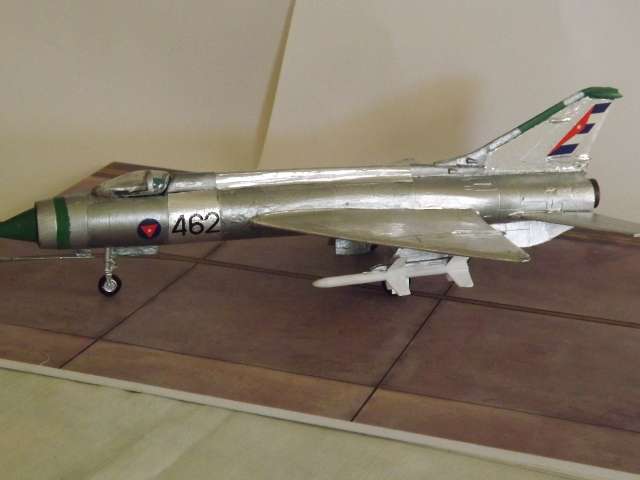
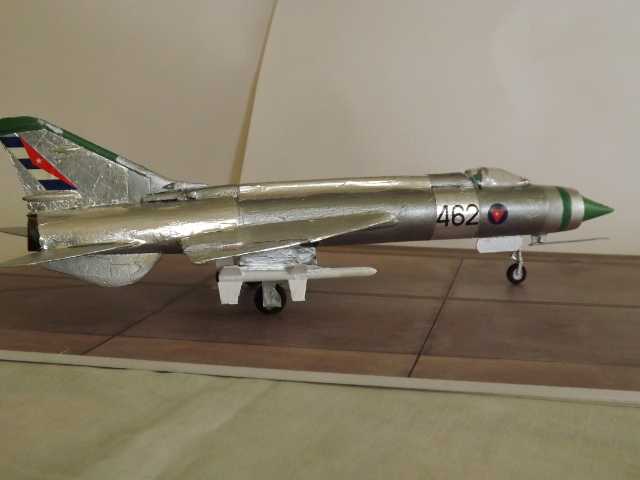
The Kit
The kit is a Neomega Resin model, built OOB except for the markings which came from an aftermarket sheet for the MiG21. It was, at the time, the most expensive model I owned. It was quite a reasonable model. Brush painted with extra panels from foil.
To fulfill the needs of the PVO (Protivovozdushnaya Oborona – air defence forces) for a heavy interceptor to carry out automatic interceptions, the MiG bureau had developed a range of large fighter aircraft starting with the swept wing I-3 series (a.k.a. I-380, I-410 and I-420), followed by the I-7 and the I-75. The requirement for supersonic interception speed and the ability to carry the heavy avionic systems dictated the size; in comparison the contemporary MiG-21F (similar in layout), weighed 4,819 kg (10,624 lb) and was 15.76m (51 ft 8-1/2in) long, compared with 12,345 kg (27,215 lb) and 18.14m (59 ft 6in) respectively, for the Ye-150.
The MAP (Ministerstvo Aviatsionnoy Promyshlennosti - ministry of aviation industry) ordered the Mikoyan OKB to build prototypes of the new interceptor, to be armed with either K-6, K-7, K-8, K-9, unguided rockets, or an aimable twin cannon installation. Automatic guidance to the interception point was to be provided by Urugan-5 (hurricane-5) integrated weapons systems.
Ye-152A
The Mikoyan-Gurevich Ye-152A was a twin-engined version of the Ye-152, sharing its general layout but utilising two Tumansky R-11 afterburning turbojets mounted side by side in a revised rear fuselage. The change in engine type, necessitated by the extremely poor reliability of the R-15, led to a widened rear fuselage with large ventral fins. The majority of the airframe was identical to the Ye-152, incorporating the extended inlet and fuselage found to be advantageous during testing for the proposed Ye-151 cannon armed variant of the Ye-150. Due to the use of fully developed and reliable R-11 engines the Ye-152A was ready for flight in July 1959 and continued to fly on test duties at the Mikoyan-Gurevich test centre until it crashed in 1965.
Armament was to have been two K-9 air-to-air missiles, as part of the Ye-152-9-V weapon system, featuring the TsKB Almaz TsP-1 fire control radar.
The Ye-152A was assigned the NATO reporting name Flipper after a flypast during the 1961 Aviation Day display at Tushino and also erroneously labelled as the MiG-23.
Uragan-5
Development of the Uragan-5 automatic weapon system was initiated by the Council of Ministers in 1955 to intercept supersonic bombers flying at 10-25,000m ( ft) altitude at 1600–2000 km/hour up to 100–120 km range from the interceptor base, (with sufficient warning). The system relied on ground based radar to guide the interceptor to an intercept with the target and aircraft based radar and weapon aiming systems to complete the mission using the following components:
A high resolution ground based radar system, to provide accurate position and height data at a range of 345 km.
Active interrogation system (SAZO)
Automatic guidance facility
Digital control computer
Command data link (SPK)
Interceptor-fighter with Airborne radar (detection range of 25 km minimum), Autopilot, and Weapon-aiming computer (SRP)
Armament options included:
2 x 30mm cannon in a tilting rotatable mount.
Unguided rockets.
2x Grushin K-6 air-to-air missiles
2x Toropov K-7 air-to-air missiles
2x Kaliningrad K-8 (R-8) air-to-air missiles
2x Raduga K-9 air-to-air missiles
A combination of delays in development of the electronic components, missiles and poor reliability of the Tumansky R-15 engines for the aircraft component led to the Uragan-5 system, fitted to Ye-150 derivatives being cancelled in 1962.
Adoption of the Ye-152a
The PVO adopted in limited numbers the Ye-152a as the MiG-22. As part of the Mastrovoka campaign against Western Intelligence, the aircraft was given a different identification which Western Intelligence Agencies had erroneously given it (MiG-23). However, the MiG-22 was not a success and was quickly superseded by the Sukhoi Su-15.
This however did not prevent the MiG-22 being sold overseas to client states of the Soviet Union. Both the Cuban Air Force and the Indonesian Air Force adopted it. Both felt the need for a fast climbing, heavily armed interceptor which would allow them to protect their island nations.
After the 1962 Cuban Missile Crisis when Cuba was heavily dependent on the Soviet Union for it's protection against an impeding American attack and invasion, the MiG-22P (Perekhvatchik “Interceptor”) was supplied to the island nation. Armed initially with K9 “AWL” missile which looked impressive, even if it performed badly, the missile was quickly superseded by the much shorter ranged but more reliable K13 Atoll missile. This actually fitted more closely with the Russian's plans for the Cubans, preferring to keep their aircraft on a “short leash” rather than arming it with the longer-ranged K9s. The K9 missiles were however kept for intelligence purposes and nearly all photos of the MiG-22 in Cuban service show it carrying the larger, less reliable missile.


The Kit
The kit is a Neomega Resin model, built OOB except for the markings which came from an aftermarket sheet for the MiG21. It was, at the time, the most expensive model I owned. It was quite a reasonable model. Brush painted with extra panels from foil.
Last edited:
The F-106 in RAF Service
As we have seen, Duncan Sandys was forced to resign because of his sexual peccadillo with the Duchess of Argyll. His replacement was John Profumo. In late 1957, Profumo handed down the much expected Defence White Paper. It promised savage cuts to an already over-extended and increasingly out of date RAF. All aircraft contracts for fighters and strike aircraft were to be cut, immediately. Instead the RAF would go over to using guided missiles. Fighters were to be replaced by long range Surface to Air missiles and strike aircraft by IRBMs (Intermediate Range Ballistic Missiles) initially and then, once developed, ICBMs (Inter-Continental Ballistic Missiles), both of which were to be situated in “silos” below ground, in the British countryside.
John Profumo had done his deed. He had saved the British tax-payers millions of pounds but at the expense of several tens of thousands of workers' jobs. Profumo, as we know was later forced to resign because of his involvement with Christine Keeler. The RAF began to “wind down”. Aircraft were not replaced, except with missiles. Within five years, the RAF was only a shadow of it's former self. British aircraft manufacturing had been devastated.
The RAF realised that whilst missiles looked good on the cover of magazines, they were not quite as useful at policing the airspace of the UK. Soviet bombers started approaching closer and closer as the numbers of fighters were retired. The scandal finally broke when a Soviet Bear bomber, allegedly “blown off course” overflew Belfast without challenge in broad daylight. London was alarmed. Washington was horrified. London urgently requested that the USAF station more fighters in the UK. Washington complied, on the understanding that the UK would either restart its aircraft manufacturing or purchase aircraft from America. It did both.
Here we have an example of the later. An F-106C Delta-Dart F.1 of 3 Squadron RAF wearing a commemorative set of markings in 1970, stationed “somewhere in Britain”. It carries internally four AIM-4, one AIR-2 Genie and an M61 Vulcan 20mm cannon.
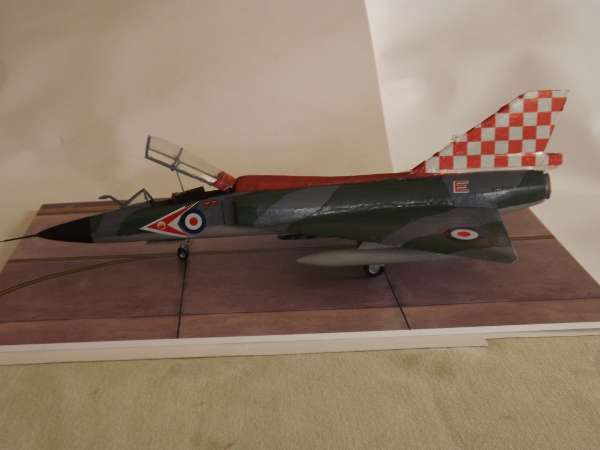
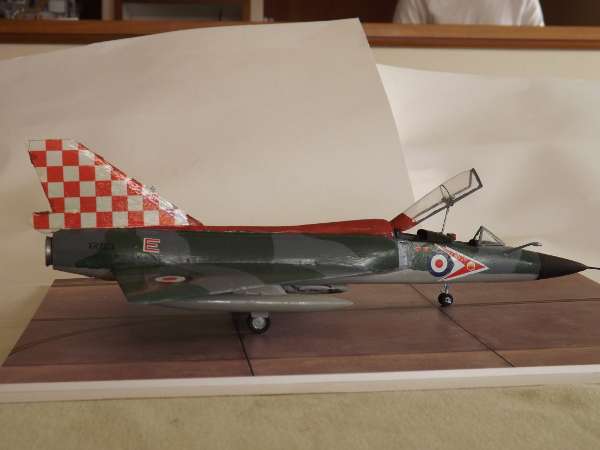
The Kit
The model is an ancient Hasagawa F-106A, to which I added the nose conversion from Falcon Vacuforms for the F-106B. The nose was quite simple to add, although a fair degree of PSR was required to even out the pieces. I also added a Vulcan pod, from the sparesbox, made from a drop tank for a Gnat T.1. The markings came from a combination of Kit Spackman Enterprises (the tail checks) and an Xtradecal Lightning set.
As we have seen, Duncan Sandys was forced to resign because of his sexual peccadillo with the Duchess of Argyll. His replacement was John Profumo. In late 1957, Profumo handed down the much expected Defence White Paper. It promised savage cuts to an already over-extended and increasingly out of date RAF. All aircraft contracts for fighters and strike aircraft were to be cut, immediately. Instead the RAF would go over to using guided missiles. Fighters were to be replaced by long range Surface to Air missiles and strike aircraft by IRBMs (Intermediate Range Ballistic Missiles) initially and then, once developed, ICBMs (Inter-Continental Ballistic Missiles), both of which were to be situated in “silos” below ground, in the British countryside.
John Profumo had done his deed. He had saved the British tax-payers millions of pounds but at the expense of several tens of thousands of workers' jobs. Profumo, as we know was later forced to resign because of his involvement with Christine Keeler. The RAF began to “wind down”. Aircraft were not replaced, except with missiles. Within five years, the RAF was only a shadow of it's former self. British aircraft manufacturing had been devastated.
The RAF realised that whilst missiles looked good on the cover of magazines, they were not quite as useful at policing the airspace of the UK. Soviet bombers started approaching closer and closer as the numbers of fighters were retired. The scandal finally broke when a Soviet Bear bomber, allegedly “blown off course” overflew Belfast without challenge in broad daylight. London was alarmed. Washington was horrified. London urgently requested that the USAF station more fighters in the UK. Washington complied, on the understanding that the UK would either restart its aircraft manufacturing or purchase aircraft from America. It did both.
Here we have an example of the later. An F-106C Delta-Dart F.1 of 3 Squadron RAF wearing a commemorative set of markings in 1970, stationed “somewhere in Britain”. It carries internally four AIM-4, one AIR-2 Genie and an M61 Vulcan 20mm cannon.


The Kit
The model is an ancient Hasagawa F-106A, to which I added the nose conversion from Falcon Vacuforms for the F-106B. The nose was quite simple to add, although a fair degree of PSR was required to even out the pieces. I also added a Vulcan pod, from the sparesbox, made from a drop tank for a Gnat T.1. The markings came from a combination of Kit Spackman Enterprises (the tail checks) and an Xtradecal Lightning set.
The English Electric Lightning in Israeli Service
So ended the career of Duncan Sandys, before he could hand down his infamous White Paper. The consequences of which were far reaching. Instead of the RAF cancelling all aircraft development in favour of guided weapons, the British aircraft manufacturers continued to produce aircraft. The result was a proliferation of types. Some successful, some not...
In 1961, the English Electric corporation began to develop a new version of it's Lightning interceptor. Utilising a mixed powerplant consisting of a rocket motor and a Turbojet they hoped to provide the RAF with the means to intercept any approaching enemy bombers, well out into the Sea before the could approach the British coastline. The first version was a little, well "insipid" was the best word to describe it. The Avon turbojet which was chosen was just adequate to push the aircraft back to base. Roll Royce however came to the party with a new type of powerplant, a Turbofan, the Spey. When combined with a de Havilland Spectre producing approximately 10,000 lbs of thrust for over 30 minutes, the aircraft was capable a phenomenal performance, climbing to 80,000 ft in less than five minutes and reaching a speed of Mach 2+.
In 1964, English Electric went on a sales drive, attempting to sell their new interceptor to primarily small countries which did not require long range but require high performance such as Singapore, Brunei, Sri Lanka, Israel. They had considerable success in all of them. In Tel Aviv in particular, fears of the Arab Bomb drove their acquisition of the Lightning F.7 as it had been christened by the RAF. They up armed their aircraft, using the overwing pylons for two additional Sidewinders in addition to the two Red Top missiles normally carried, with of course two 30mm ADEN cannons.
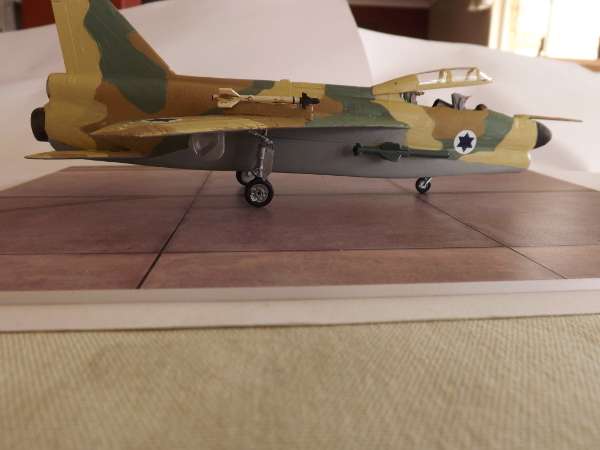
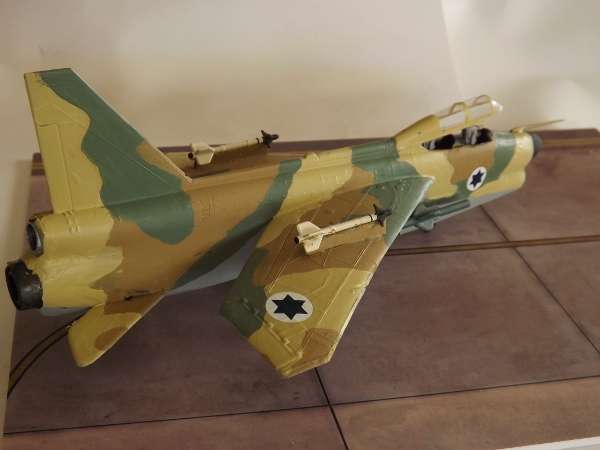
The Kit
It is a bit of a mashup. I found an old Matchbox Tempest and used the spare nose in that. I then opened up the front cockpit for the pilot, used a lot of spare sprue, plasticard and Milliput, a load of PSR and hey, presto! The Sidewinders came from the spares box and the markings off an Israeli sheet I have. The canopy came from a Delfin trainer.
'Headless men' in sex scandal named
Unidentified lover in Duchess of Argyll divorce case exposed as not one but two men - a cabinet minister and a swashbuckling movie star
Sarah Ball
It was a scandal that rocked the nation: an aristocratic beauty was photographed performing fellatio on a lover, while shots of another man gratifying himself were unearthed in her boudoir.
The sexually explicit Polaroid snaps proved central in the 1958 divorce of the Duke and Duchess of Argyll, and became part of a government investigation.
The duchess's reputation was ruined, but her lover escaped nearly blameless, his identity forgotten d for almost 40 years by the camera cutting him off at the neck.
Tonight, the mystery of the "headless man" - or rather headless men - is resolved for the first time, with new evidence identifying not one, but two, lovers.
The man in the more notorious shot is unveiled as Duncan Sandys, then a cabinet minister, and his masturbating rival as Douglas Fairbanks Jr, the Hollywood legend who dallied with Marlene Dietrich and married Joan Crawford.
The two men's identities are revealed in a Channel 4 documentary to be shown tonight, Secret History: The Duchess and the Headless Man, which draws on the memories of the duchess's confidante, who identifies Sandys, and previously unpublished evidence gathered by the nation's then most senior law lord, Lord Denning. This formed part of his inquiry into security risks which resulted in the resignation of the then secretary of state for war, John Profumo.
Sandys's identity is "conclusively proved", the documentary makers believe, by the duchess's claim that the only Polaroid camera in the country at the time had been lent to the Ministry of Defence, where Sandys was a minister. Fairbanks is nailed by his handwriting.
The Argyll case, heard in March 1958 - was the longest and most sensational divorce to occur in Britain.
Margaret Argyll, the only child of a self-made Scottish millionaire, was a society beauty who her husband alleged had slept with 88 men, including two cabinet ministers and three royals.
At a stormy cabinet meeting on June 20, Sandys, the son-in-law of Winston Churchill, confessed he was rumoured to be the person in the erotic shots, which, at that time, were presumed to be of one man.
He offered to resign but Macmillan managed to dissuade him by ensuring Lord Denning, who had been commissioned to investigate the Profumo scandal, also investigated the identity of the headless lover.
For this Denning, the master of the rolls, had a plan. On the four shots of the man in different states of arousal were handwritten captions: "before", "thinking of you", "during - oh", and "finished". If he could match the handwriting, he would find his man.
He invited the five key suspects - Sandys, Fairbanks, American businessman John Cohane, Peter Combe, an ex-press officer at the Savoy, and Sigismund von Braun, the diplomat brother of the Nazi scientist Werner von Braun - to the Treasury and asked for their help in a "very delicate matter".
As they arrived, each signed the visitor's register. Their handwriting was analysed by a graphologist, and the results proved conclusive. As the broadcaster Peter Jay, then a young Treasury official, tells the documentary: "The headless man identified by the handwriting expert and therefore identified by Lord Denning, though he didn't write this down in his report, was, in fact, the actor Douglas Fairbanks Jr."
Duncan Sandys, who in 1974 was given a peerage, appeared to be in the clear - a fact confirmed by a Harley Street doctor who concluded his pubic hair did not correspond with that in the masturbation photos.
But tonight's documentary confirms the other photograph clearly showed a different man whose identity the duchess hinted at to her close friend Paul Vaughan just before her death.
"She did say to me quite clearly that, 'Of course, sweetie, the only Polaroid camera in the country at this time had been lent to the Ministry of Defence,'" recalls Mr Vaughan. "If that wasn't running a flag up the flag pole, I don't know what was. She wanted someone to know." Analysis of the film suggests the photo was taken in 1957, at which stage Sandys held his defence post.
"We believe it's pretty definitive," said Dan Corn, the programme's producer. "It's ironic because he effectively got away with it by being cleared by Denning."
The duchess died in a Pimlico nursing home in July 1993, without even hinting at the identity of her other lover. But despite this discretion, she never recovered from her reputation being so besmirched during her divorce.
Summing up, the judge, Lord Wheatley, said: "She was a highly sexed woman who had ceased to be satisfied with normal relations and had started to indulge in disgusting sexual activities."
So ended the career of Duncan Sandys, before he could hand down his infamous White Paper. The consequences of which were far reaching. Instead of the RAF cancelling all aircraft development in favour of guided weapons, the British aircraft manufacturers continued to produce aircraft. The result was a proliferation of types. Some successful, some not...
In 1961, the English Electric corporation began to develop a new version of it's Lightning interceptor. Utilising a mixed powerplant consisting of a rocket motor and a Turbojet they hoped to provide the RAF with the means to intercept any approaching enemy bombers, well out into the Sea before the could approach the British coastline. The first version was a little, well "insipid" was the best word to describe it. The Avon turbojet which was chosen was just adequate to push the aircraft back to base. Roll Royce however came to the party with a new type of powerplant, a Turbofan, the Spey. When combined with a de Havilland Spectre producing approximately 10,000 lbs of thrust for over 30 minutes, the aircraft was capable a phenomenal performance, climbing to 80,000 ft in less than five minutes and reaching a speed of Mach 2+.
In 1964, English Electric went on a sales drive, attempting to sell their new interceptor to primarily small countries which did not require long range but require high performance such as Singapore, Brunei, Sri Lanka, Israel. They had considerable success in all of them. In Tel Aviv in particular, fears of the Arab Bomb drove their acquisition of the Lightning F.7 as it had been christened by the RAF. They up armed their aircraft, using the overwing pylons for two additional Sidewinders in addition to the two Red Top missiles normally carried, with of course two 30mm ADEN cannons.


The Kit
It is a bit of a mashup. I found an old Matchbox Tempest and used the spare nose in that. I then opened up the front cockpit for the pilot, used a lot of spare sprue, plasticard and Milliput, a load of PSR and hey, presto! The Sidewinders came from the spares box and the markings off an Israeli sheet I have. The canopy came from a Delfin trainer.
In the 20s and 30s what is the earliest reasonable point that an airline could develop an aircraft feasibly with the range to operate in the pacific? Say the Alaska to New Zealand route? It would not be nonstop of course, but assume several stops would be made along the way. The aircraft would almost certainly be a flying boat, and one of some size at that.
How many passengers could a plane such as this realistically carry? 6, 12, 24, 50? I imagine ticket prices would also be very expensive.
How many passengers could a plane such as this realistically carry? 6, 12, 24, 50? I imagine ticket prices would also be very expensive.
Because of the distances involved you're not going to get anything earlier than the late 30's and the Pan Am Clippers. The technology just isn't there. Any earlier than that and your only realistic option is an Airship, especially if you want to make a profit rather than live on subsidies,
Well this is from a TL of mine. But yes airships are in use to connect the two regions, and also Patagonia and a few other places. And its no real worry to make a profit as the major purpose of the airline would be to move government and military officials when needed. Im just wondering, with money as no real issue, what the earliest point such an aircraft would be feasible.Because of the distances involved you're not going to get anything earlier than the late 30's and the Pan Am Clippers. The technology just isn't there. Any earlier than that and your only realistic option is an Airship, especially if you want to make a profit rather than live on subsidies,
Like I said no earlier than 1935, neither engine or air frame technology are up to the task and even then you're really pushing it to a dangerous degree.
Dangers my middle name...Like I said no earlier than 1935, neither engine or air frame technology are up to the task and even then you're really pushing it to a dangerous degree.
But seriously thanks for the info.
Pangur
Donor
Because of the distances involved you're not going to get anything earlier than the late 30's and the Pan Am Clippers. The technology just isn't there. Any earlier than that and your only realistic option is an Airship, especially if you want to make a profit rather than live on subsidies,
If you wanted go for `what if' to get the tech faster then just may be have a Hindenburg disaster earlierLike I said no earlier than 1935, neither engine or air frame technology are up to the task and even then you're really pushing it to a dangerous degree.
I suspect the 1930s. The Empire class of flying boats are available in the Empire. The Boeing clippers and other flying boats are available from the US. You have some odd aircraft from the Soviet Union. The main problem with using those is they weren't designed all that much for passengers as for record breaking attempts at distance flying. Flying boats work well in the Pacific because of the vast amounts of water available, even if using it is nearly as complex as landing grounds.
Remember Eureka has an excellent history of an alternative use of airships - https://www.alternatehistory.com/forum/threads/remember-eureka.183013/post-4148786 - I wrote it.
Xian H-9 “Flying Tiger”
In 2014 when the Senduku Islands dispute exploded into a brief, bloody war between the PRC and Japan, the sudden appearance of a new strike aircraft flying for the PLAN came as a complete surprise to observers.
While the Xian JH-7 “Flying Leopard” was known of, it’s larger sibling, the Xian H-9 “Flying Tiger” was not. Equipped with YJ-9 “Flaming Lance” anti-shipping missile, the H-9 was a massive increase in capability.
Development of the Xian H-9 “Flying Tiger” began in 1984. Intended to be a successor to the Xian H-6 medium bomber (a modified Tu-16 built under license), the H-9 was supersonic and had a range of over 3,500 miles. Powered by a pair of Shenyang WS-11 turbofan engines with reheat, producing some 28,000 lbs of thrust, the H-9 with it’s long, super-critical wing was designed to cruise at high-subsonic speeds with a brief supersonic dash. The YJ-9 “Flaming Lance” missiles have a range of over 500 miles at subsonic speeds but carry a massive 1,000 lb warheads, which are designed to cripple even the largest ship struck by them.
The Xian H-9 “Flying Tiger” entered service in approximate 1993 and the PLAN is believed to have some 80 in service. It features, in an unusual departure from normal Chinese practice, side-by-side seating for its pilot and attack officer. It carries no internal weapons but has an extensive ECM and avionics fit, allowing it to carry out long-range strikes accurately.
The combat debut occurred during the 2014 Senduku conflict, when the Japanese provoked the Chinese into action over these lonely postage stamp sized islands by occupying them with a force of Marines and surrounding the islands with a naval task force, in an effort to assert it’s sovereignty over the islands. Ordered by the Prime Minister Shinzo Arbe, the operation backfired when the Chinese Air Force and Navy attacked. The use of the H-9 came as a complete surprise and the use of Shenyang J-11 fighters to escort them prevented their interception by the opposing force of JSDAF F-15s. Three Japanese ships were sunk in the first strike and another in the second, followup wave. The Japanese government quickly decided to withdraw their ships and evacuated the force of marines on the islands. Tokyo also immediately opened negotiations with Beijing through the United Nations in an effort to defuse the situation and prevent escalation. This did not prevent several large dog fights developing over and near the islands. The PLAAF however did not have it all it’s own way, losing 8 fighters in the engagements with their opposite Japanese numbers.
The skirmish was over before any other nation was really able to react. The United States was caught flat footed and while several squadrons of aircraft were scrambled from Japan, Guam and South Korea, and while they patrolled the edges of the dog fights, they did not get engaged because of the vacillation of Washington.
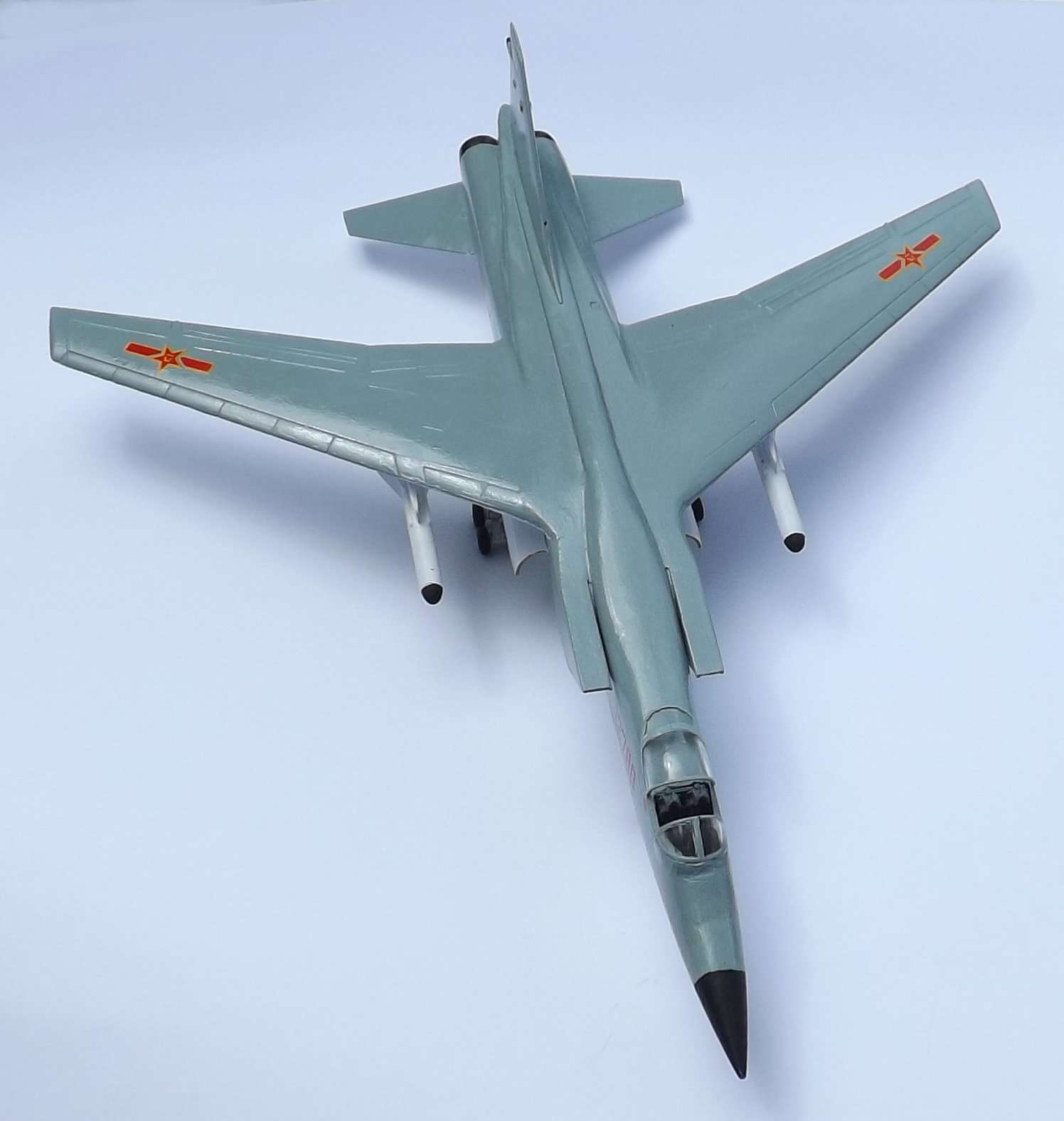
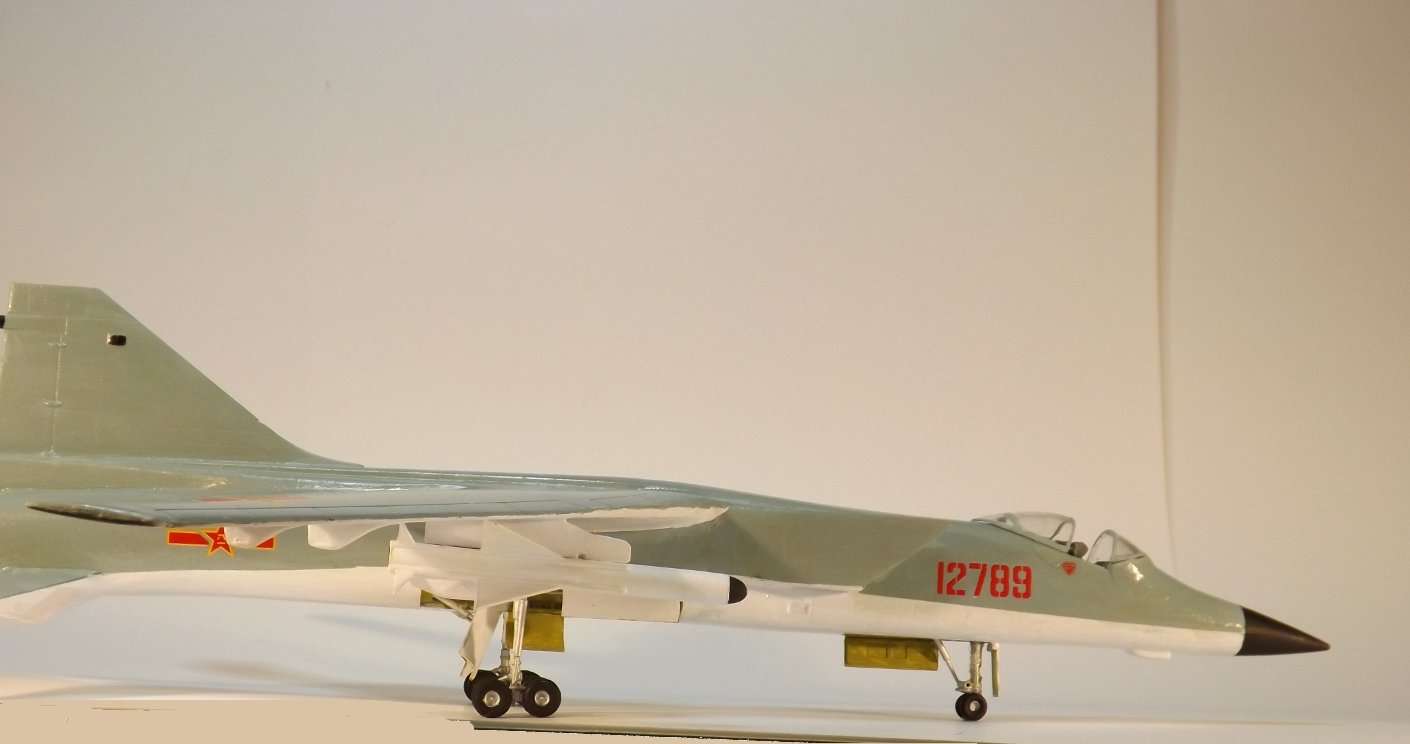
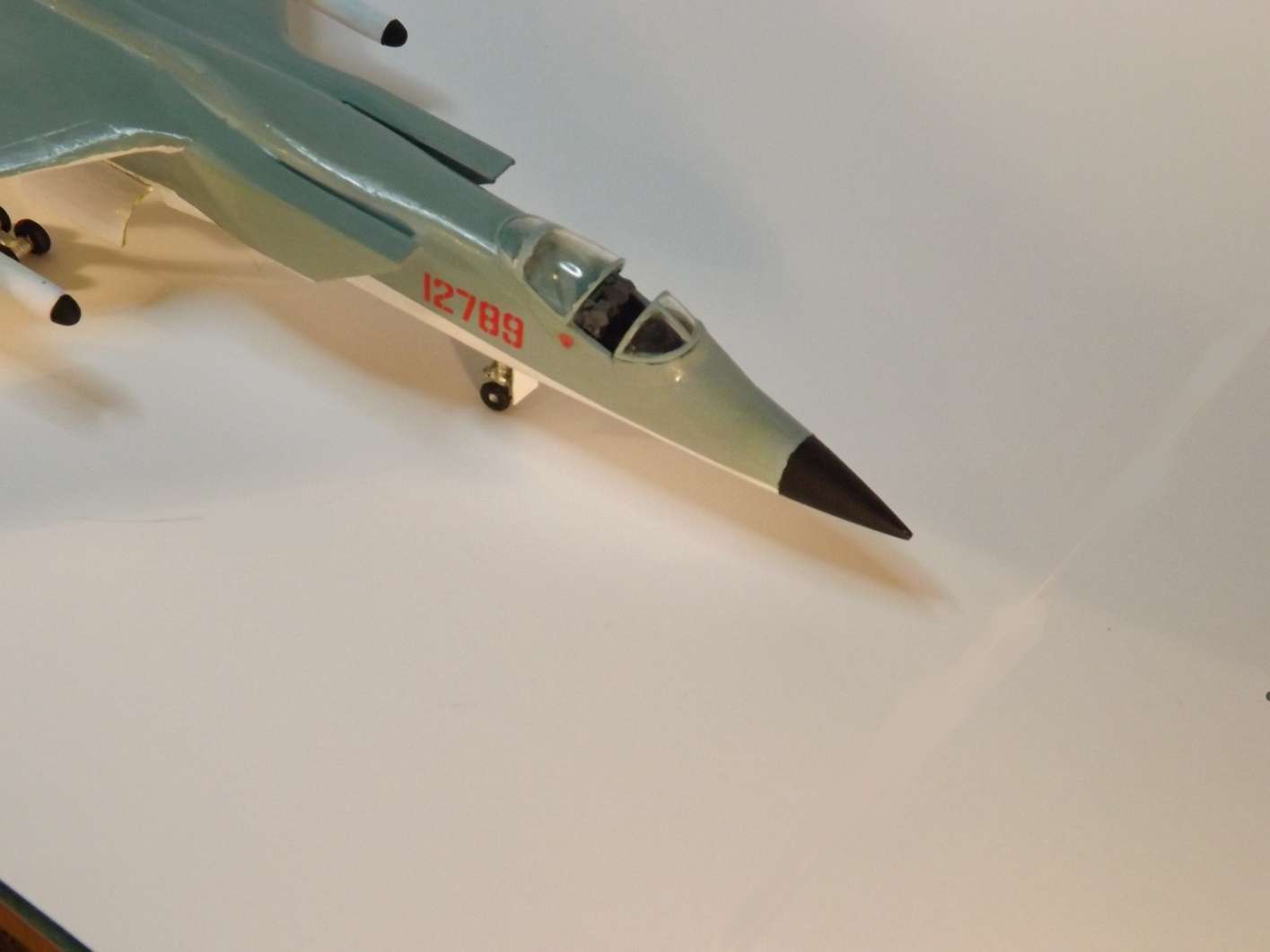
The Kit
A mashup of several different kits. Fuselage from a Mitsubishi F1 in 1/48. The wings from a 1/144 scale DC10 and the cockpit from a 1/72 scale BAC Strikemaster.
In 2014 when the Senduku Islands dispute exploded into a brief, bloody war between the PRC and Japan, the sudden appearance of a new strike aircraft flying for the PLAN came as a complete surprise to observers.
While the Xian JH-7 “Flying Leopard” was known of, it’s larger sibling, the Xian H-9 “Flying Tiger” was not. Equipped with YJ-9 “Flaming Lance” anti-shipping missile, the H-9 was a massive increase in capability.
Development of the Xian H-9 “Flying Tiger” began in 1984. Intended to be a successor to the Xian H-6 medium bomber (a modified Tu-16 built under license), the H-9 was supersonic and had a range of over 3,500 miles. Powered by a pair of Shenyang WS-11 turbofan engines with reheat, producing some 28,000 lbs of thrust, the H-9 with it’s long, super-critical wing was designed to cruise at high-subsonic speeds with a brief supersonic dash. The YJ-9 “Flaming Lance” missiles have a range of over 500 miles at subsonic speeds but carry a massive 1,000 lb warheads, which are designed to cripple even the largest ship struck by them.
The Xian H-9 “Flying Tiger” entered service in approximate 1993 and the PLAN is believed to have some 80 in service. It features, in an unusual departure from normal Chinese practice, side-by-side seating for its pilot and attack officer. It carries no internal weapons but has an extensive ECM and avionics fit, allowing it to carry out long-range strikes accurately.
The combat debut occurred during the 2014 Senduku conflict, when the Japanese provoked the Chinese into action over these lonely postage stamp sized islands by occupying them with a force of Marines and surrounding the islands with a naval task force, in an effort to assert it’s sovereignty over the islands. Ordered by the Prime Minister Shinzo Arbe, the operation backfired when the Chinese Air Force and Navy attacked. The use of the H-9 came as a complete surprise and the use of Shenyang J-11 fighters to escort them prevented their interception by the opposing force of JSDAF F-15s. Three Japanese ships were sunk in the first strike and another in the second, followup wave. The Japanese government quickly decided to withdraw their ships and evacuated the force of marines on the islands. Tokyo also immediately opened negotiations with Beijing through the United Nations in an effort to defuse the situation and prevent escalation. This did not prevent several large dog fights developing over and near the islands. The PLAAF however did not have it all it’s own way, losing 8 fighters in the engagements with their opposite Japanese numbers.
The skirmish was over before any other nation was really able to react. The United States was caught flat footed and while several squadrons of aircraft were scrambled from Japan, Guam and South Korea, and while they patrolled the edges of the dog fights, they did not get engaged because of the vacillation of Washington.



The Kit
A mashup of several different kits. Fuselage from a Mitsubishi F1 in 1/48. The wings from a 1/144 scale DC10 and the cockpit from a 1/72 scale BAC Strikemaster.
Last edited:
So, what did they operate from the deck of the HMS Queen Elizabeth, then?
With the launch of HMS Queen Elizabeth the Royal Navy found itself needing a considerably larger Carrier-Onboard-Delivery aircraft than the Fairey Gannets it had used up until that date for the emergency delivery and withdrawal of personnel and equipment that had to be rushed to or from it's carriers.
The Dornier Do.31 filled the bill perfectly.
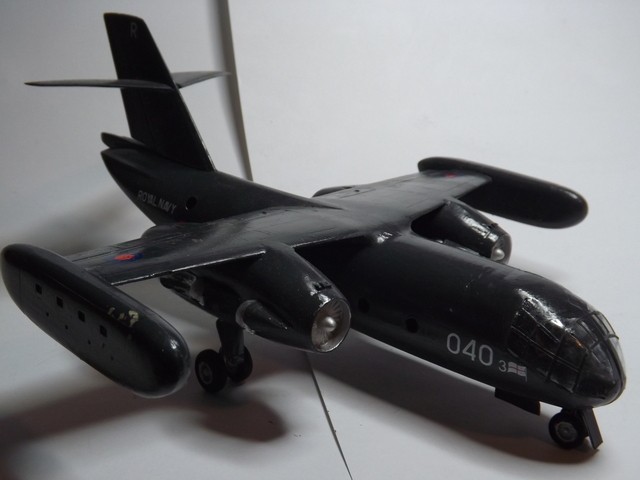
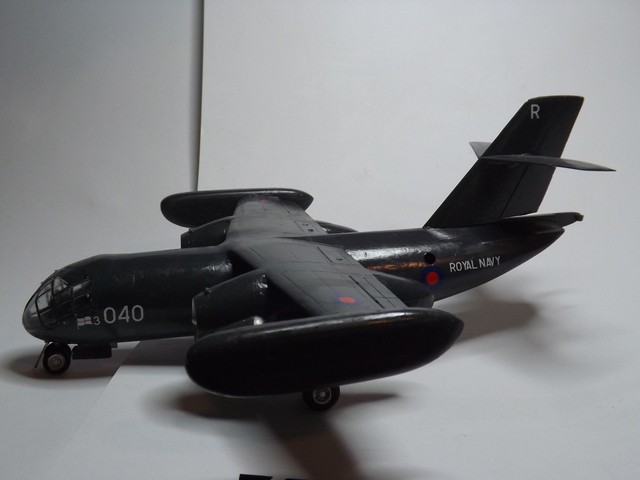
The Kit
The kit is a Planet Resin one. Apologies for the darkness of the pictures. It became darker and darker with the application of Future to the already darker grey that I used. Brush painted and decals from an aftermarket Gannet set.
Last edited:
The real TSR.2 - the Folland Wasp
6 April 1965 is considered an infamous anniversary in the minds of many aircraft enthusiasts. On that date, The BAC TSR.2 was cancelled.
But what if, instead of attempting to buy the moon, the RAF had accepted that it needed to trim its sails to suit the available cloth? Perhaps a smaller, ligher, more versatile and above all else, much cheaper aircraft such as proposed by Teddy Petter should have been accepted as the TSR.2?
I give you the Folland TSR.2 Wasp. Powered by twin afterburning Rolls-Bristol RB.153 engines, with top speed of Mach 2.4 the Wasp was a worthy successor to the legend of the Mosquito. Carrying a single WE.177 nuclear weapon, it had a range of approximately 1,500 miles. Carrying two crew and terrain avoidance radar, stationed well forward in West Germany, the Wasp was capable of reaching Moscow if necessary.
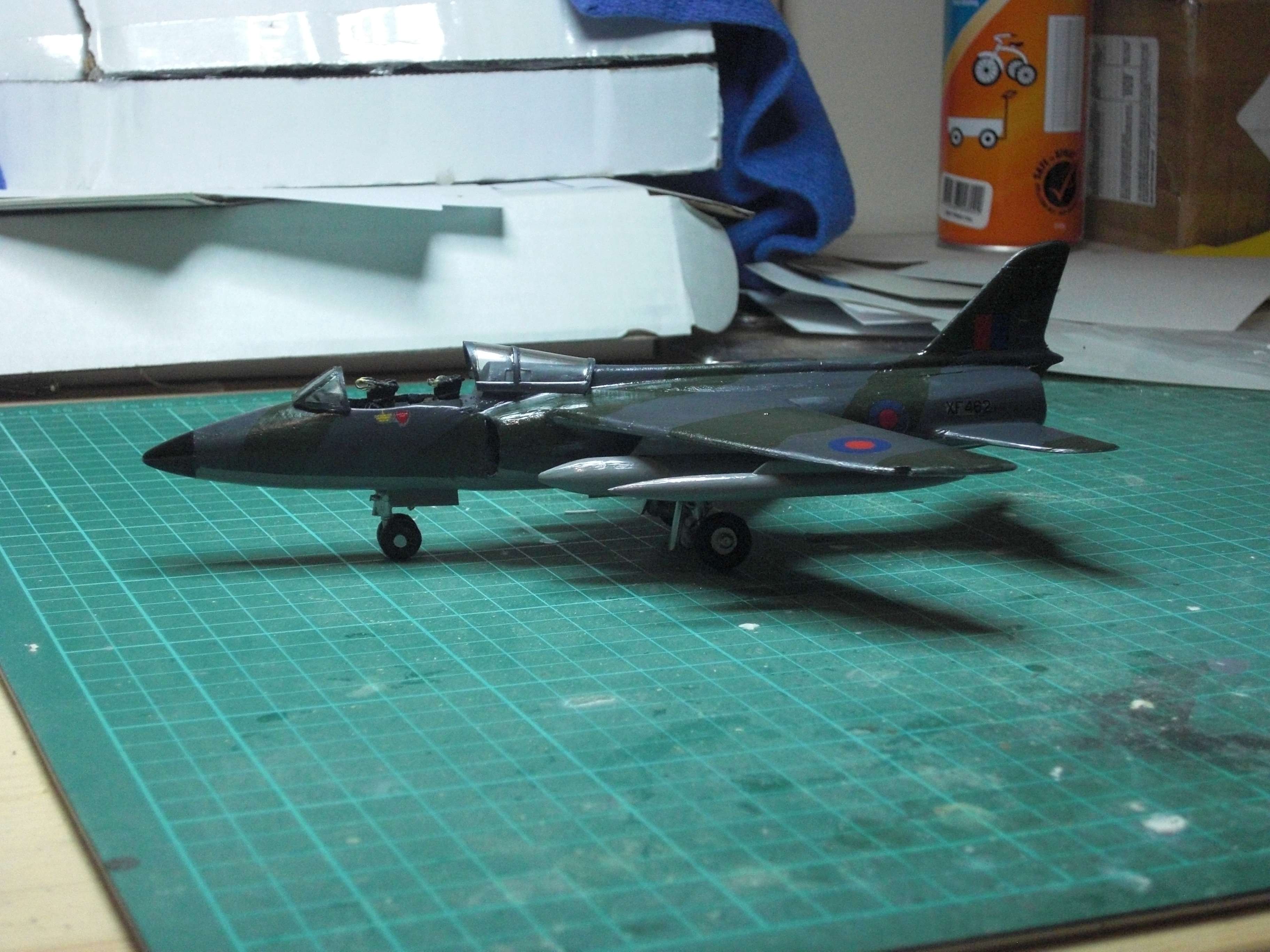
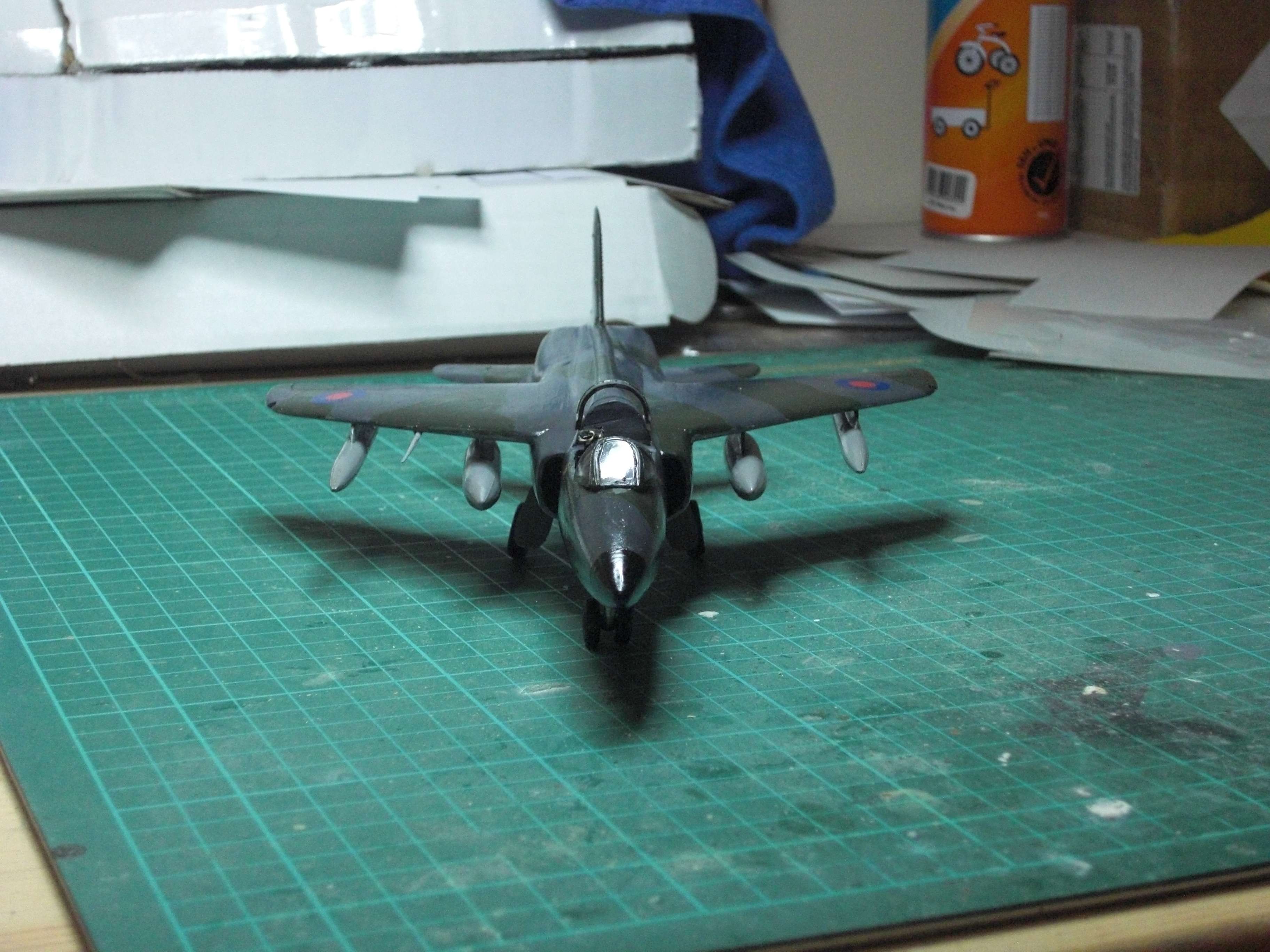
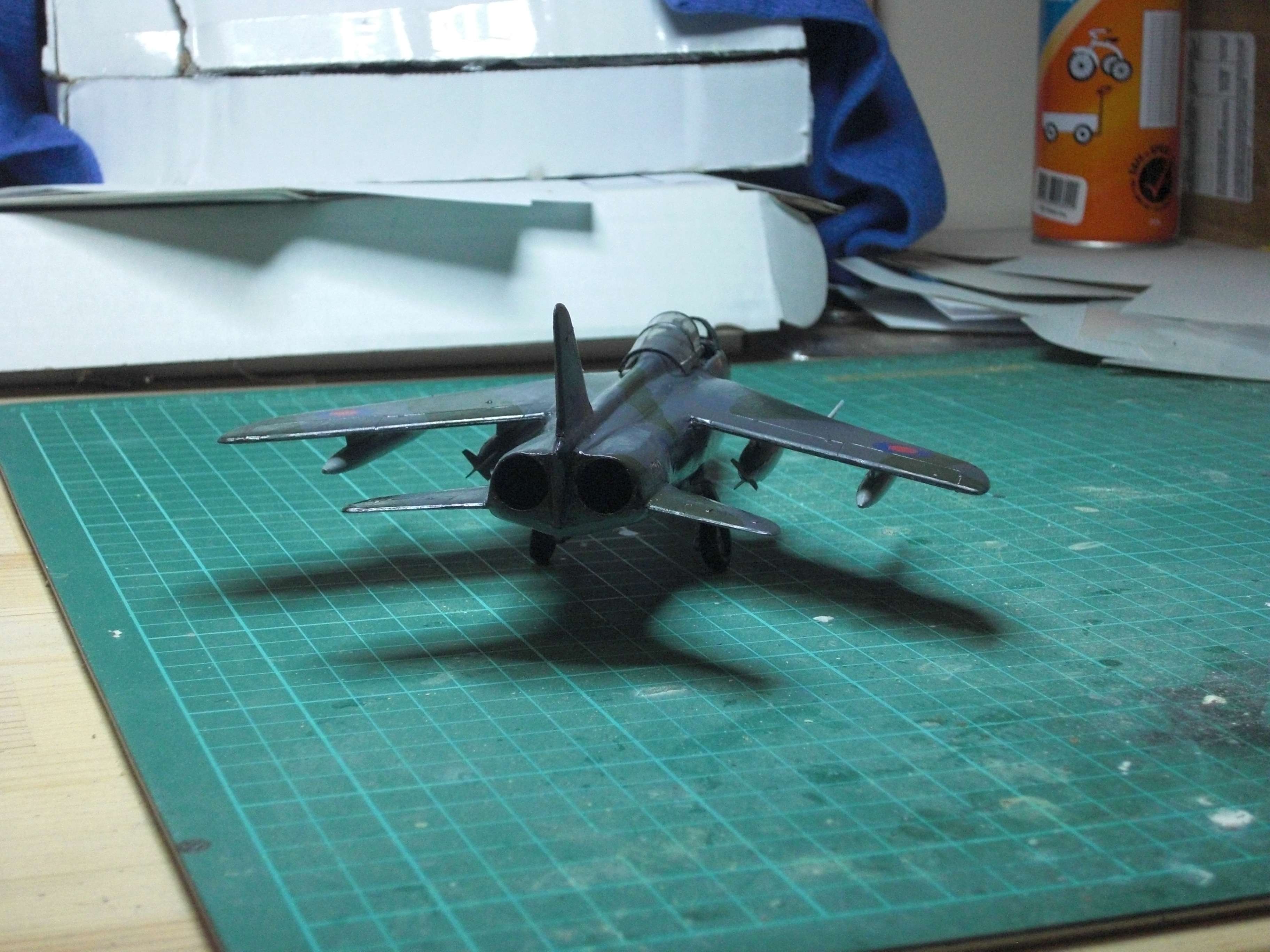
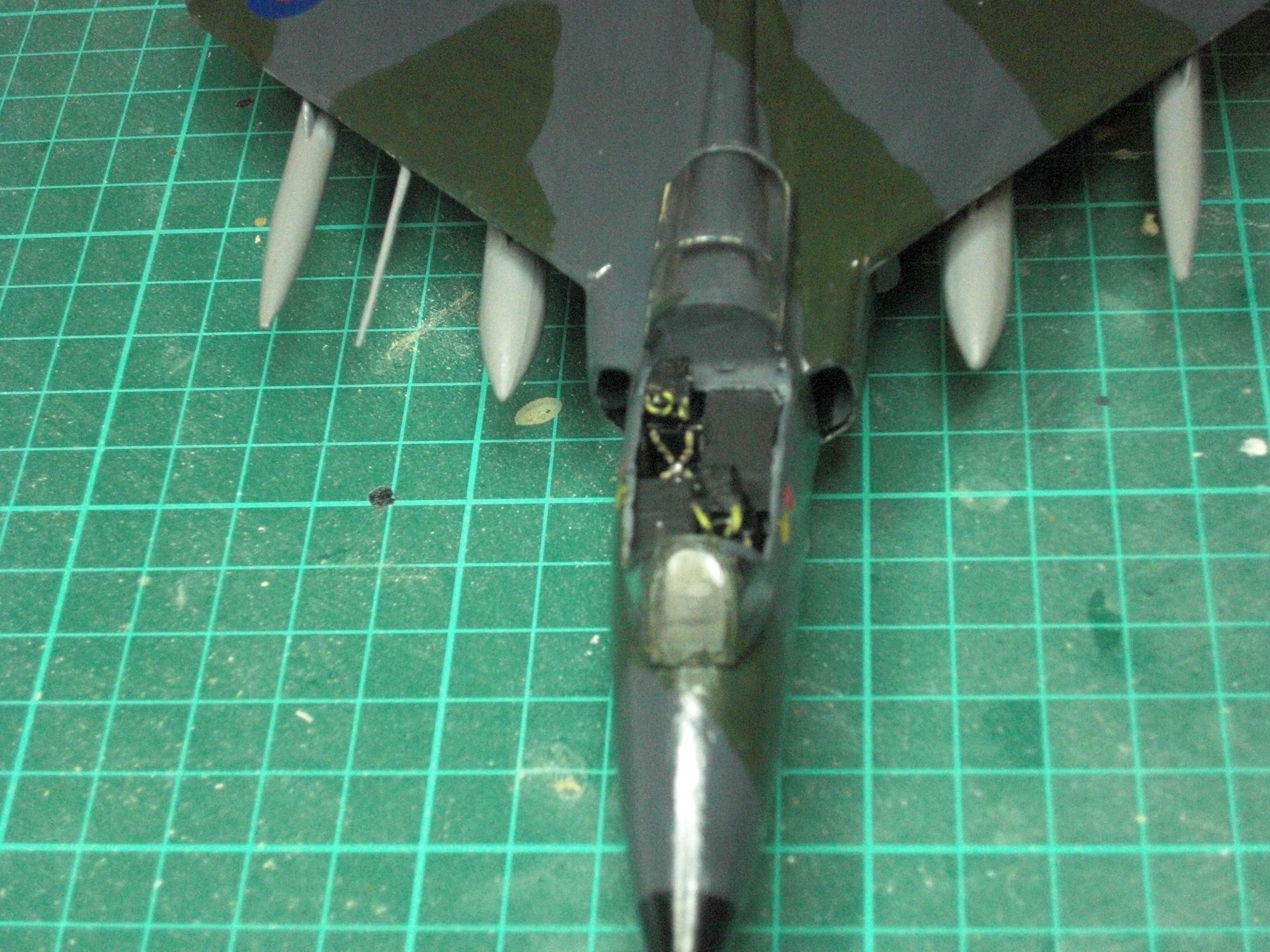
The Kit
Built from an ancient and largely inaccurate 1/50 Kader Gnat F.1, I extended the fuselage, added two seats and added twin engines at the rear. Came out rather well, I thought. Brush painted with a hairy stick from Vallejo and Tamiya paints. Decals from the spares box.
Last edited:
The Grumman 134R LARA entry
The LARA competition was to create the OV-10 Bronco - a light, armed reconniassiance aircraft for COIN operations. Along the way entries were received from various manufacturers, including Grumman. Twin turboprop powered and heavily armed the aircraft was a twin seater.
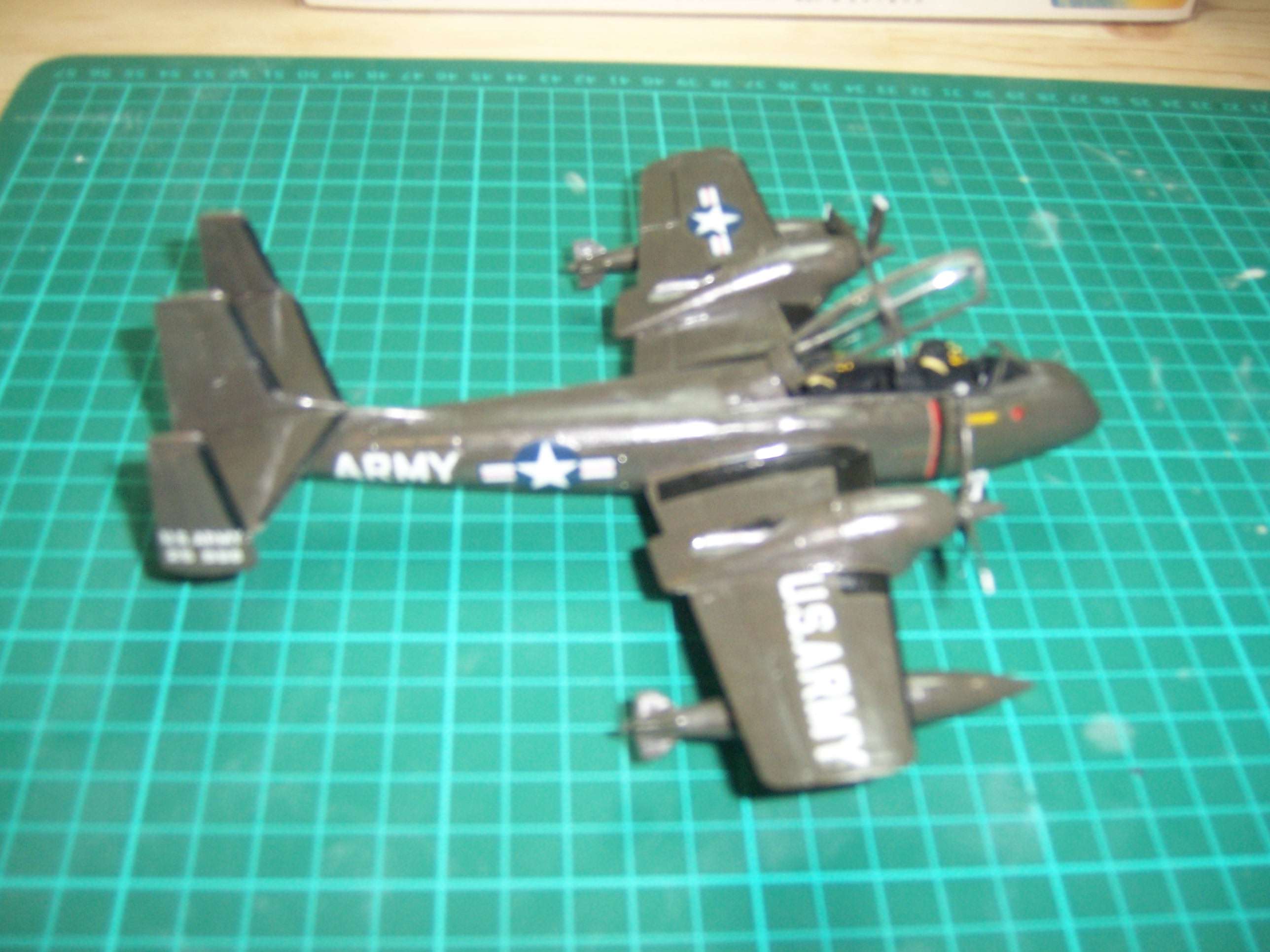
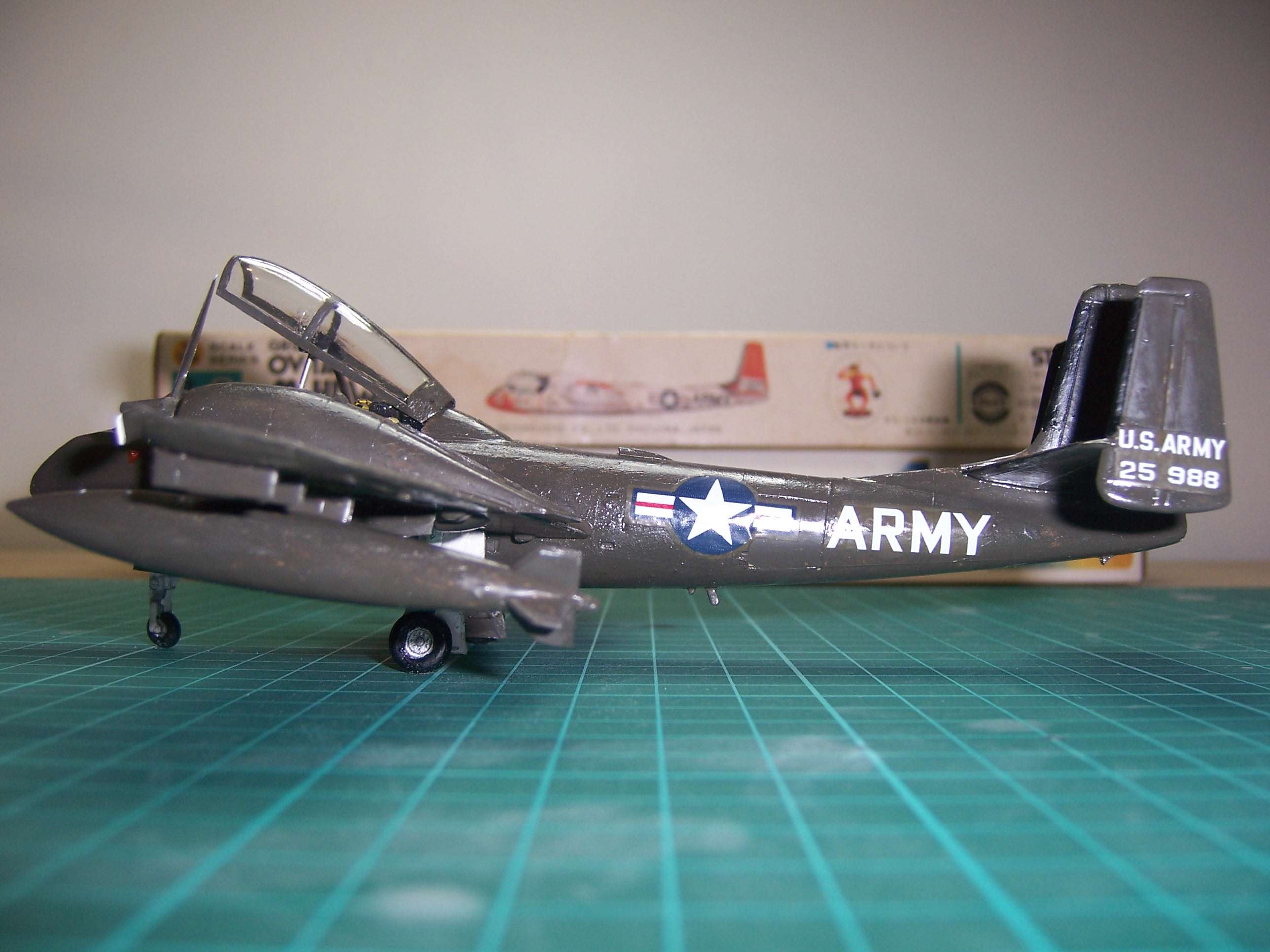
The Kit
What do you get when you combine these two kits? You end up with this, the Grumman 134R for the US Army's LARA competition or rather my interpretation of it. Combining the nose of a TA-4 and the body of a Grumman Mohawk, finish with a hairy stick and the decals from an old ESCI set.
The LARA competition was to create the OV-10 Bronco - a light, armed reconniassiance aircraft for COIN operations. Along the way entries were received from various manufacturers, including Grumman. Twin turboprop powered and heavily armed the aircraft was a twin seater.


The Kit
What do you get when you combine these two kits? You end up with this, the Grumman 134R for the US Army's LARA competition or rather my interpretation of it. Combining the nose of a TA-4 and the body of a Grumman Mohawk, finish with a hairy stick and the decals from an old ESCI set.
Pangur
Donor
Never heard of it before. I am trying to visualize it in South Vietnamese colours for some reasonThe Grumman 134R LARA entry
The LARA competition was to create the OV-10 Bronco - a light, armed reconniassiance aircraft for COIN operations. Along the way entries were received from various manufacturers, including Grumman. Twin turboprop powered and heavily armed the aircraft was a twin seater.


The Kit
What do you get when you combine these two kits? You end up with this, the Grumman 134R for the US Army's LARA competition or rather my interpretation of it. Combining the nose of a TA-4 and the body of a Grumman Mohawk, finish with a hairy stick and the decals from an old ESCI set.
Share: